- LAGRANGIAN
- Posts
- Issue 60 | Breaking Space News: July 20 - 26, 2025
Issue 60 | Breaking Space News: July 20 - 26, 2025
Snowfall in a Chilean Desert & a Newborn Planet — This Week in Space: Betelgeuse Has a Mate, CosmoCube, and the First Antimatter Qubit — Plus: NASA–ISRO, Russia–Iran Launches, South Korean Lunar Base, the Climate Tipping Point, Ocean Heatwaves, Marine Protection Outcomes, Spain's Thirty Meter Telescope Interest, China’s Oversight Standards, Bioplastics for Space & More

Explorer, welcome back!🚀
Thanks for joining us this week. Space Science has a lot to offer this week, with some updates from the commercial and defense sectors in space. NASA’s struggles continue.
Talk to us. We talk back on Discord, Instagram, LinkedIN, and TikTok. The publication reads better on the link below.
Hope you enjoy this Space!
CosmoCube-Miniature Radiometer will Listen to Cosmic Dark Ages From the Lunar Far Side
NASA–ISRO Earth Observation Satellite Set for July 30 Launch
Satellite and AI Analysis Reveals that Strong Marine Protections Effectively Deter Illegal Fishing
Standardized Supernovae Catalog Challenges Existing Cosmological Framework: Dark Energy is Evolving
Russia Completes Space Weather Constellation, Launches Iran’s Telecom Satellite
US Reconnaissance Office Taps Hydrosat for On-Orbit Thermal Infrared Data
Space Force Simulates Commercial Satellite Mobilization in Orbital Crisis Drill
Space-Based Missile Defense Gains Momentum with Interagency Push Across US Initiatives
Spire Expands Space-Based RF Intelligence for Defense Applications
AST SpaceMobile Seeks FCC Approval for Direct Satellite Coverage to First Responders
China Introduces Sector-Wide Standards for Space Infrastructure
Lockheed Eyes Selling Commercial Orion Flights for Deep Space After Artemis
Blue Origin to Launch Scout's AI-Based Orbital Surveillance Sensor Aboard Blue Ring in 2026

IMAGES
Rare Snowfall in the Atacama Desert : MODIS (Moderate Resolution Imaging Spectroradiometer) instrument, Terra Satellite, NASA

A rare snowstorm blanketed Chile’s high-altitude Atacama Desert on June 25, disrupting operations at the ALMA Observatory and revealing the region’s vulnerability to shifting atmospheric patterns. Triggered by a cold-core cutoff low, the event marked the first significant snowfall in over a decade. Satellite imagery showed rapid sublimation, the transformation of snow directly into a gas, due to extreme solar irradiance, evidence of the desert’s unique climate dynamics. The incident highlights how even the driest places on Earth are not immune to episodic weather extremes driven by broader climatic variability. (Credit: NASA/Wanmei Liang/USGS/MODIS/NASA EOSDIS LANCE and GIBS/Worldview)
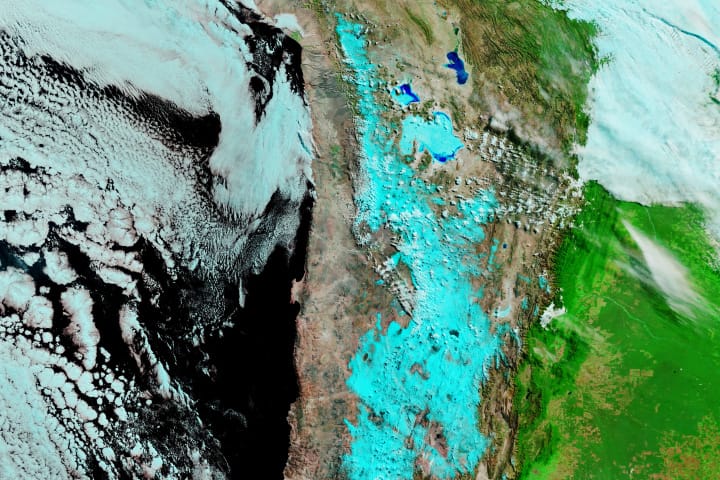
This image shows snowfall across the Altiplano captured on June 26, 2025, the day after the storm. High elevation, clear skies, cloud composition, and its Southern Hemisphere location contribute to unusually intense solar irradiance. (Credit: NASA/Wanmei Liang/USGS/MODIS/NASA EOSDIS LANCE and GIBS/Worldview)
Long-Predicted Stellar Companion of Betelgeuse : Gemini North Telescope, Hawai’i
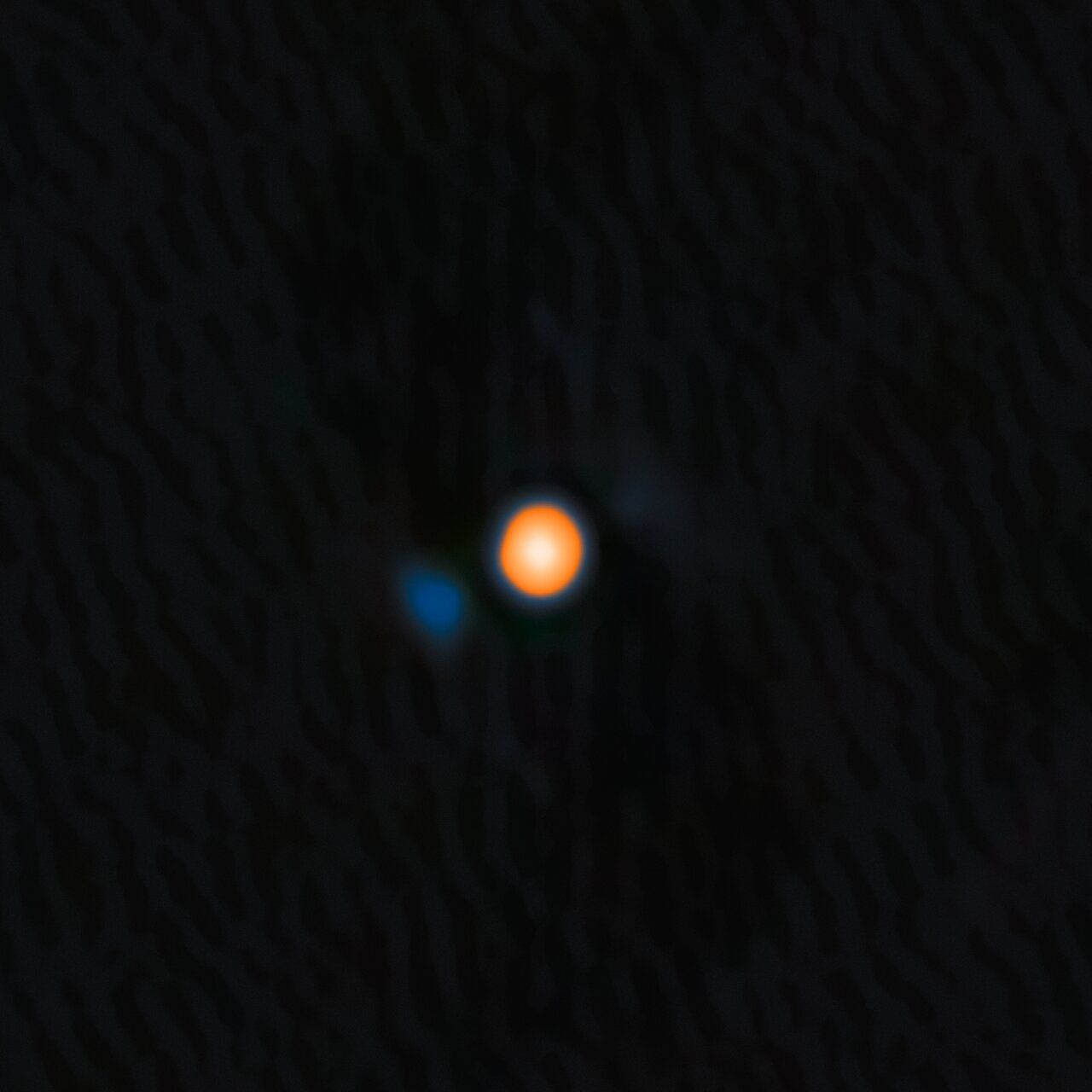
Astronomers using the Gemini North telescope in Hawai‘i have directly imaged a long-predicted companion star orbiting Betelgeuse, resolving a centuries-old mystery about the red supergiant’s brightness fluctuations. The faint, hot companion lies deep within Betelgeuse’s extended atmosphere and may explain its six-year variability cycle. Detected via speckle imaging with the ‘Alopeke instrument, the discovery marks the first confirmed close-in companion to a supergiant star. Researchers estimate the companion will spiral into Betelgeuse within 10,000 years. (Credit: International Gemini Observatory/NOIRLab/NSF/AURAImage Processing: M. Zamani (NSF NOIRLab))
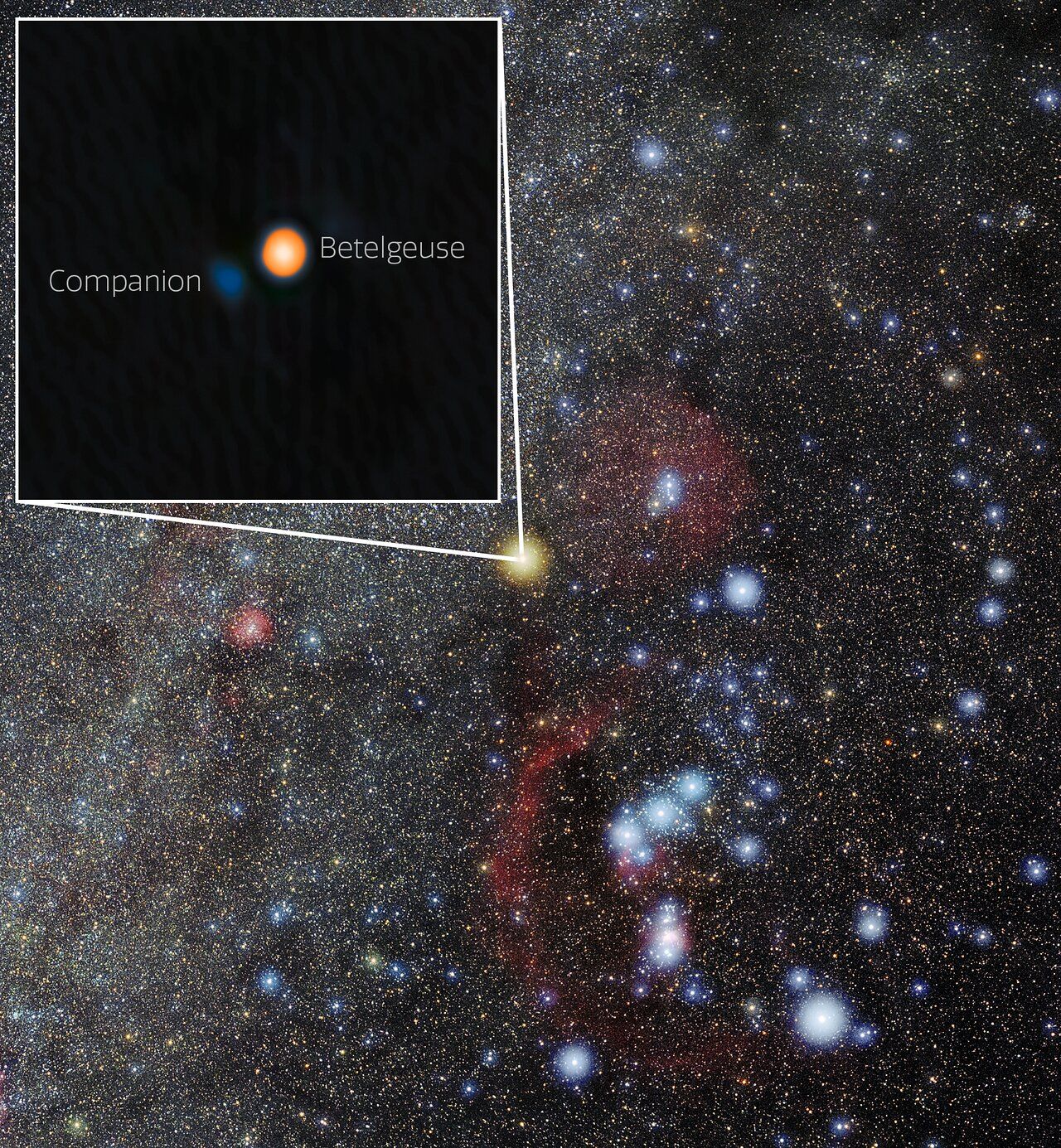
Astronomers using the ‘Alopeke instrument on the Gemini North telescope have identified a tightly orbiting companion star around Betelgeuse, resolving the long-standing mystery of its six-year brightness cycle. The newly detected star is likely an A- or B-type—hot, blue-white, and key to understanding variability in red supergiants. (Credit: International Gemini Observatory/NOIRLab/NSF/AURA, Image Processing: M. Zamani (NSF NOIRLab))
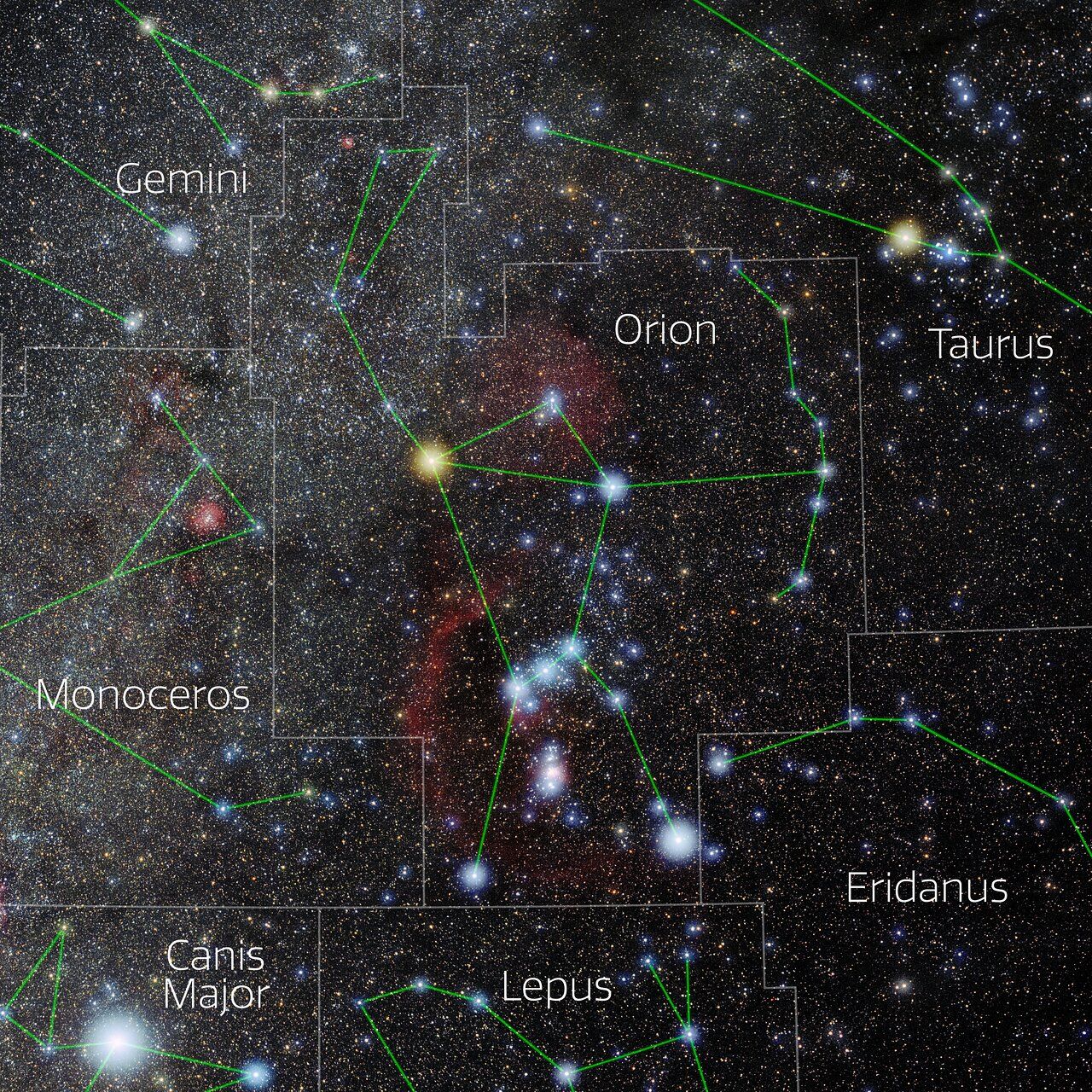
A photograph of the constellation Orion with annotations from IAU and Sky & Telescope. (Credit: E. Slawik/NOIRLab/NSF/AURA/M. Zamani)
A Newborn Planet : ESO’s Very Large Telescope (VLT), Chile
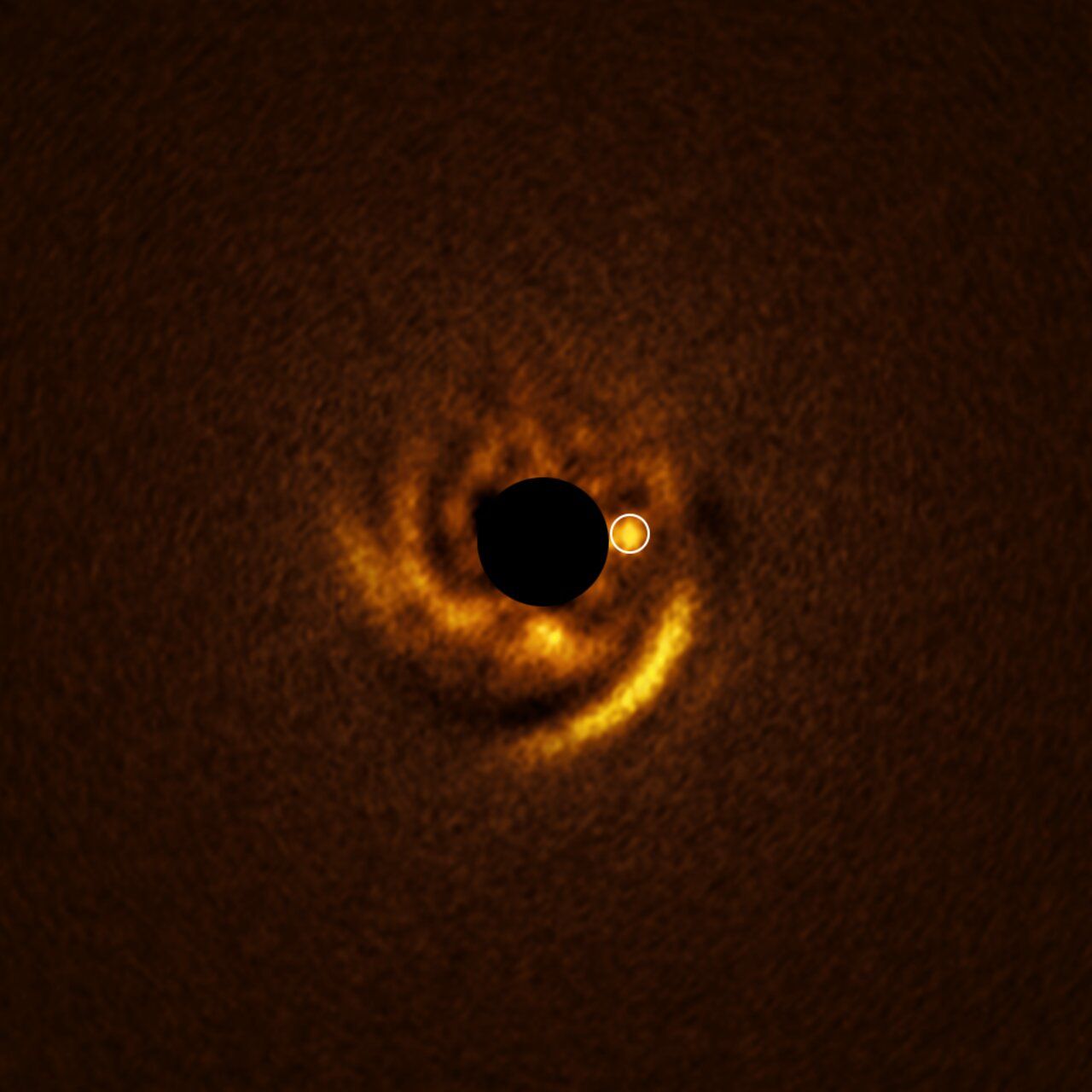
Astronomers using ESO’s Very Large Telescope have identified a planet candidate embedded within the spiral arms of the protoplanetary disc surrounding HD 135344B, a young star 440 light-years away. The detection, made with the Enhanced Resolution Imager and Spectrograph (ERIS) instrument, marks the first time a planet has been directly observed shaping such spirals—long theorized to result from planetary formation. Estimated at twice Jupiter’s mass, the object appears to be actively sculpting its environment, offering rare insight into early planet formation. (Credit: ESO/F. Maio et al.)
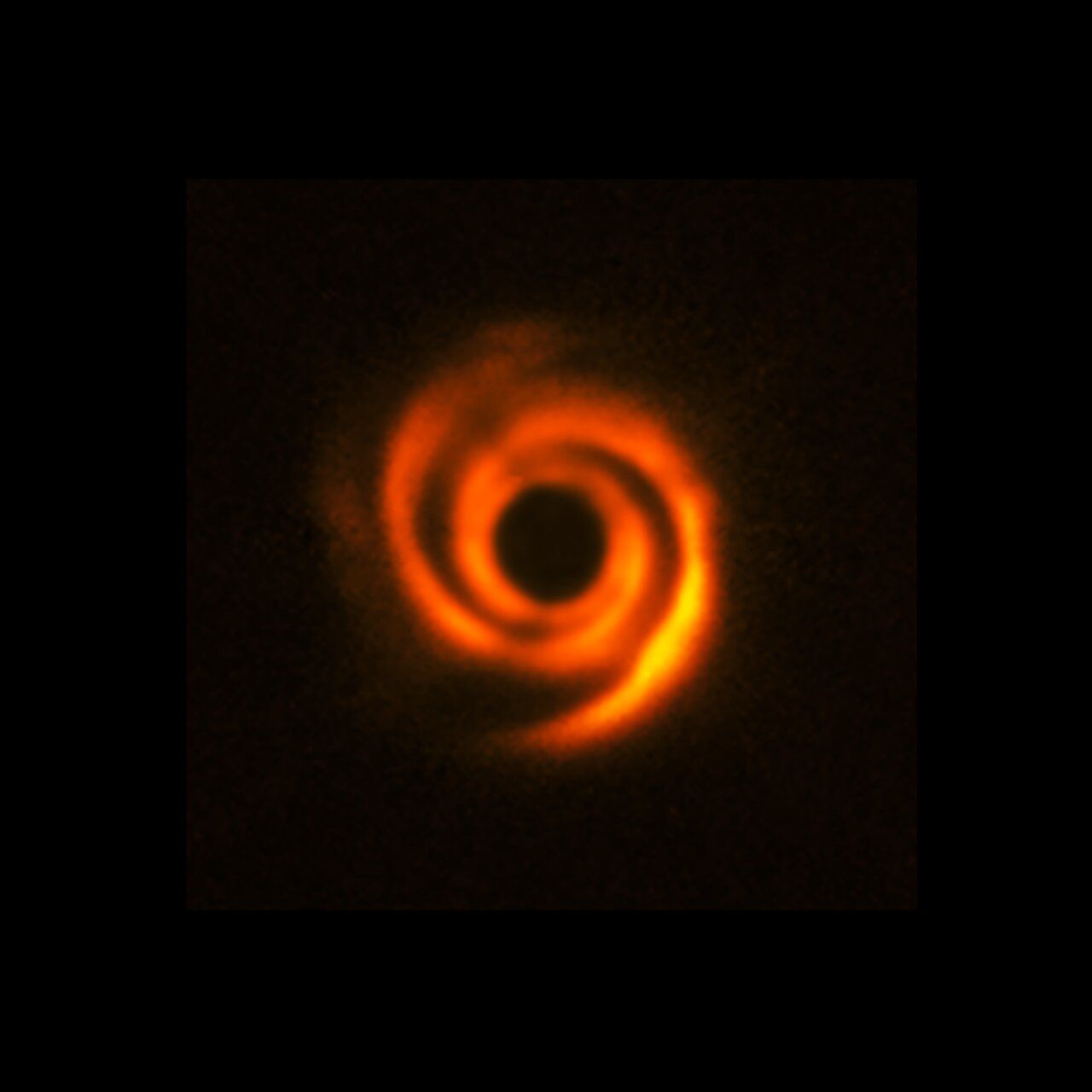
This image, which was released in 2016, was obtained with the Spectro-Polarimetric High-contrast Exoplanet Research (SPHERE) instrument.
Spiral features like these can be sculpted by planets, although this image doesn’t show evidence of companions orbiting HD 135344B. However, new observations at somewhat longer wavelengths, obtained with the Enhanced Resolution Imager and Spectrograph (ERIS) at the VLT, have found a possible young planet around this star. (Credit: ESO/T. Stolker et al.)
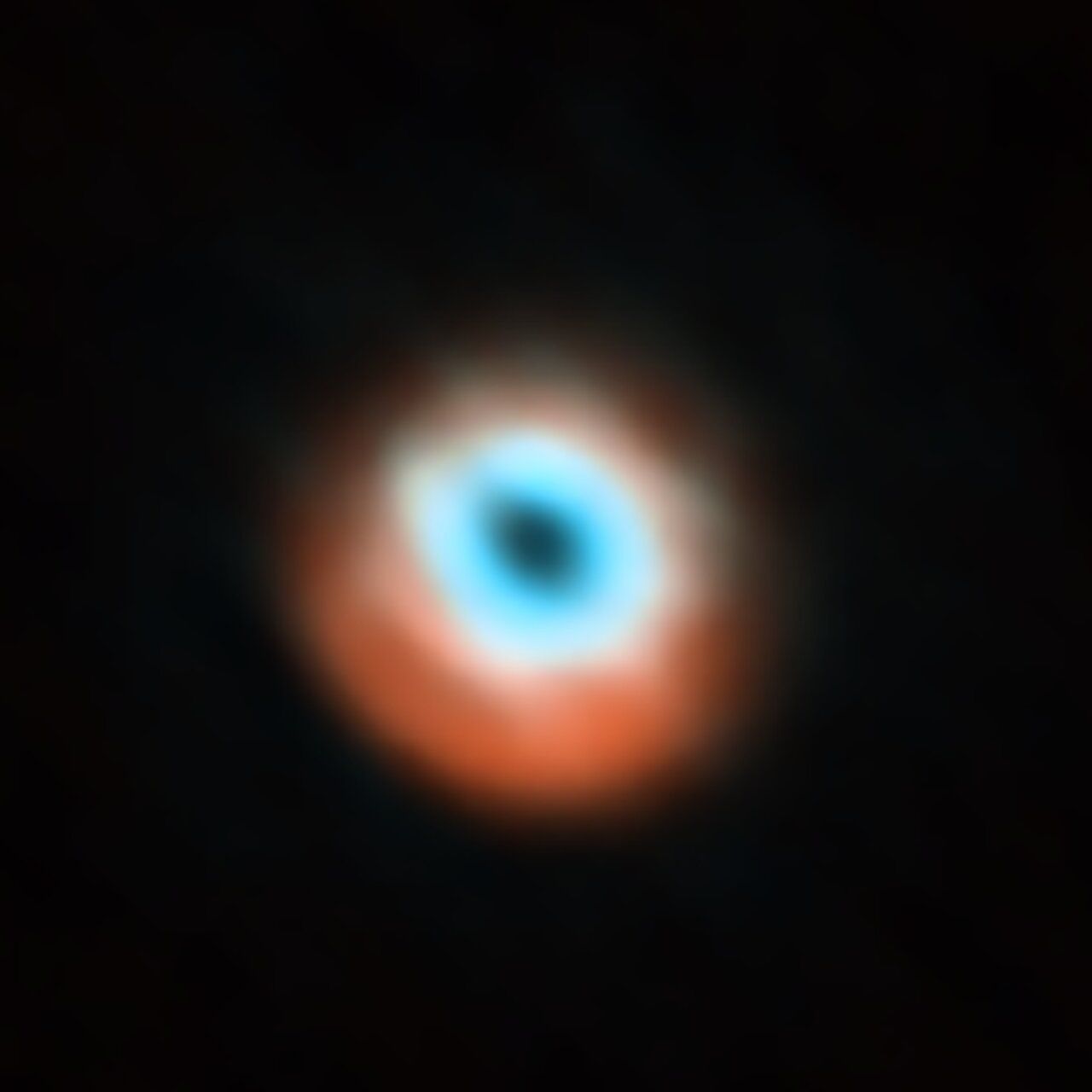
This image, taken with the Atacama Large Millimeter/submillimeter Array (ALMA), and first released in 2015, shows a planet-forming disc around the young star HD 135344B. The image combines a view of both the gas (blue) and the dust (orange) around the star. The star itself is invisible at these wavelengths, and is located in the central gap of the disc. (Credit: ALMA (ESO/NAOJ/NRAO)/N. van der Marel et al.)
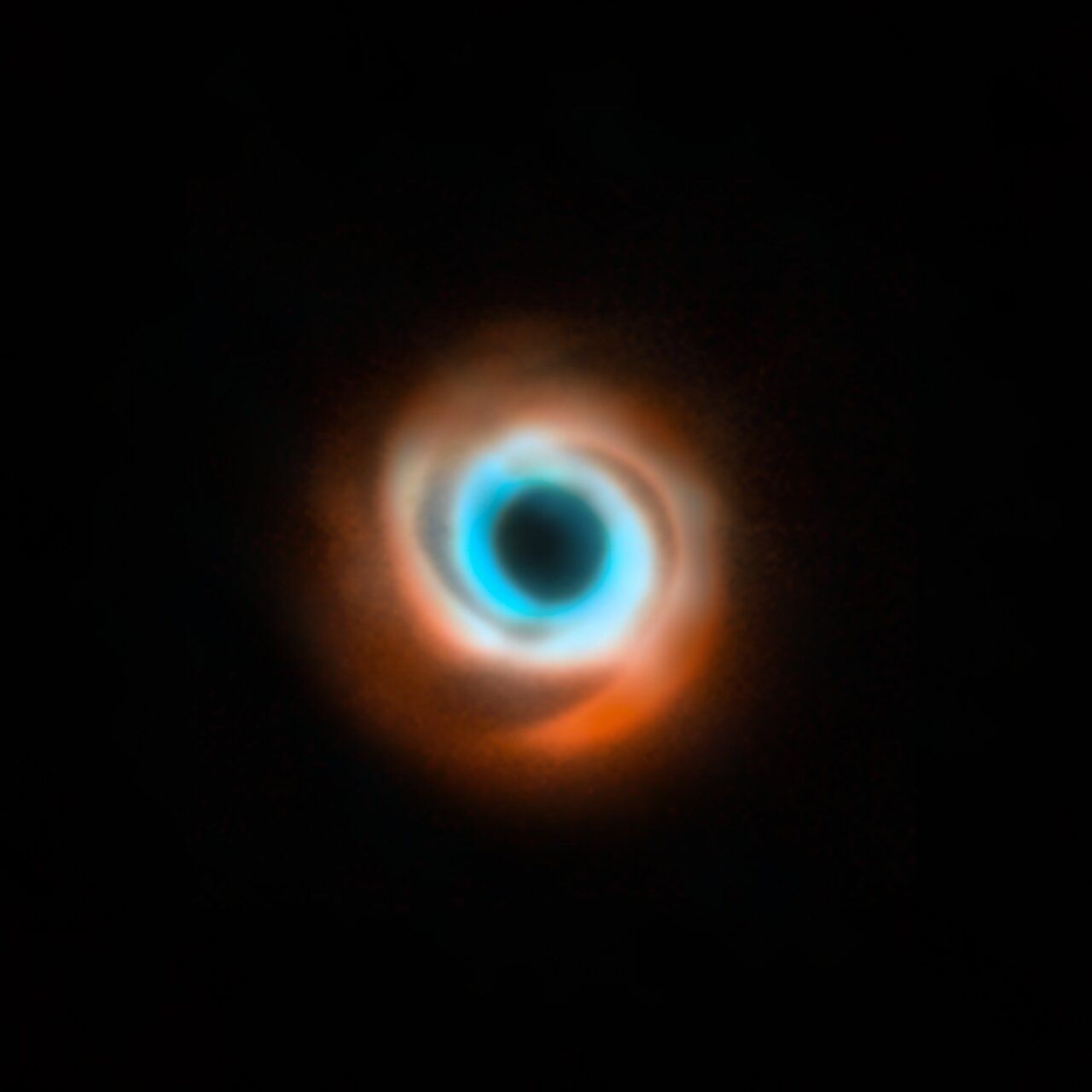
This image shows the dusty disc around the young star HD 135344B. It’s a combination of data taken with two different facilities: the Spectro-Polarimetric High-contrast Exoplanet Research (SPHERE) instrument at ESO’s VLT in red, and the Atacama Large Millimeter/submillimeter Array (ALMA) in orange and blue. The original SPHERE and ALMA images were released in 2016 and 2015 respectively and didn’t show evidence for the presence of a planet in this disc, first revealed in 2025. (Credit: ESO/T. Stolker et al./ALMA (ESO/NAOJ/NRAO)/N. van der Marel et al.)
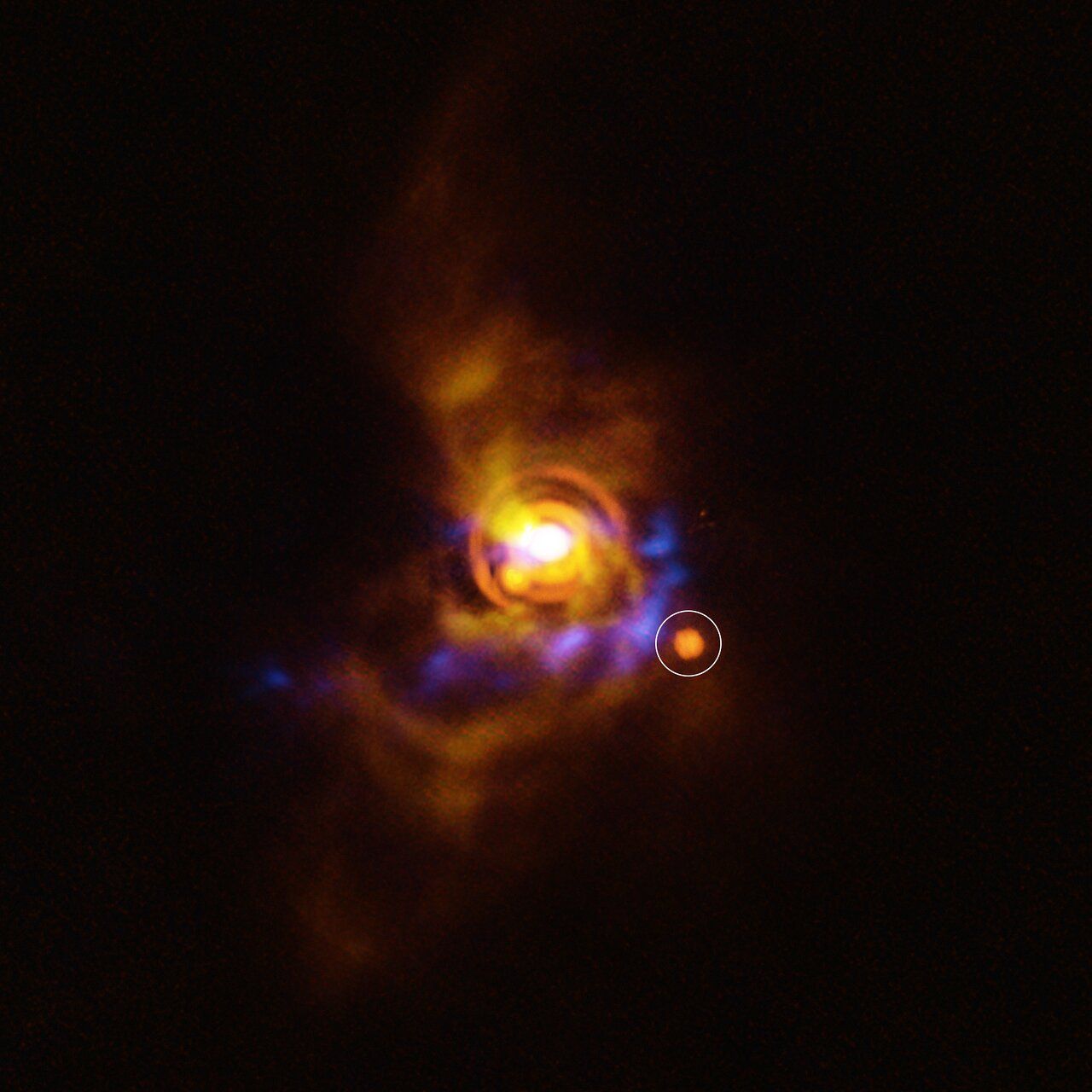
In parallel, another team observed V960 Mon, a nascent star exhibiting gravitational instability in its surrounding disc. They detected a compact, luminous object near one of its spiral arms, possibly a forming planet or brown dwarf. If confirmed, it would be the first direct evidence of a substellar companion forming via disc fragmentation.
This image shows the possible companion orbiting V960 Mon. The star, located more than 5000 light-years away, is surrounded by a disc with intricate features. Previous analysis of the disc showed that it contains clumps of unstable material that could collapse to form a companion object. The new candidate found here could be either a planet or a brown dwarf –– an object bigger than a planet that didn’t gain enough mass to shine as a star. The candidate object was found with ESO’s Very Large Telescope (VLT), using its new Enhanced Resolution Imager and Spectrograph (ERIS). The new ERIS data are shown here in orange, overlaid on older images of the dusty disc as seen with the VLT’s SPHERE instrument (yellow) and the Atacama Large Millimeter/submillimeter Array (ALMA, in blue). (Credit: ESO/A. Dasgupta/ALMA (ESO/NAOJ/NRAO)/Weber et al.)
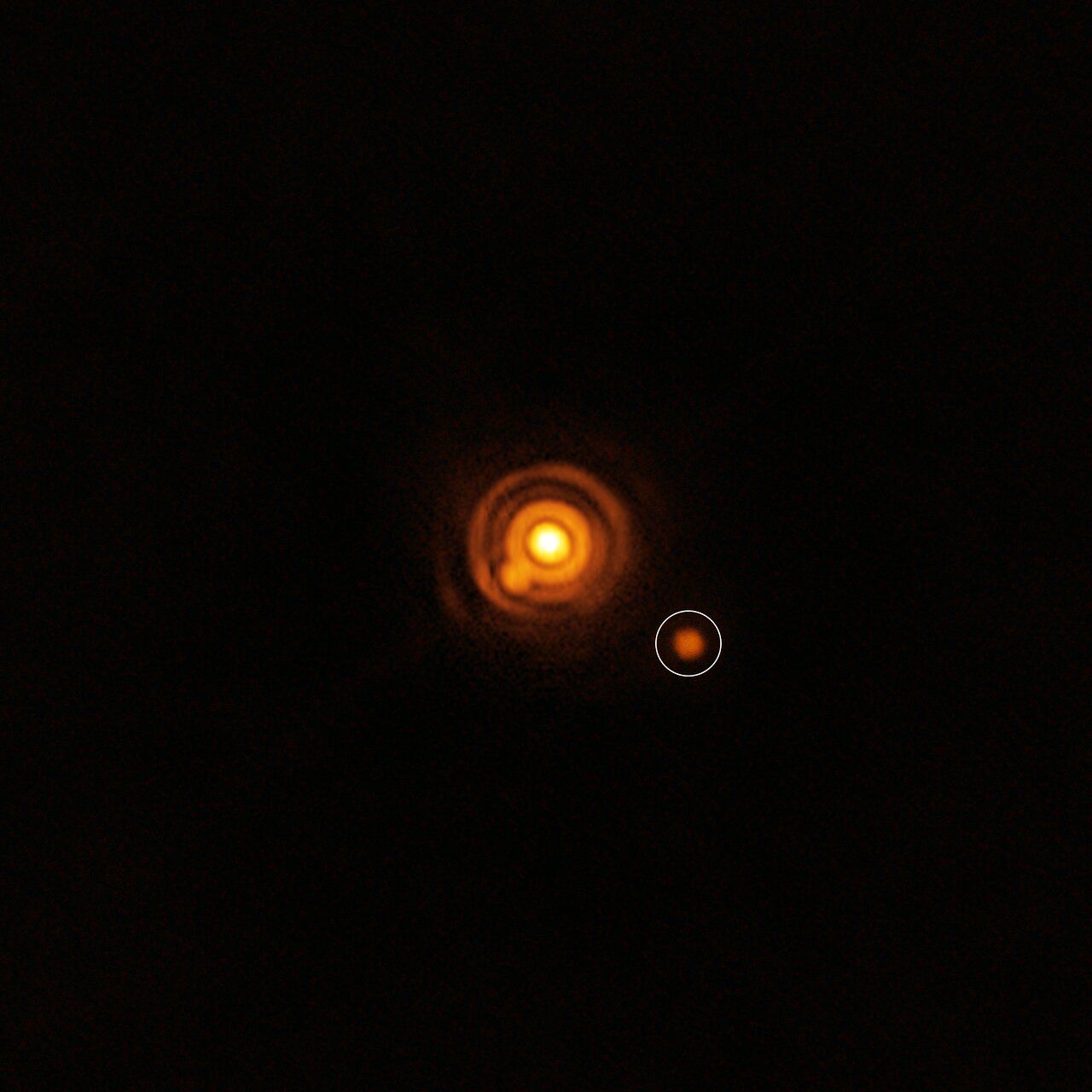
This image, taken with ESO’s Very Large Telescope (VLT), shows a possible companion orbiting the young star V960 Mon. The image was captured with the VLT’s Enhanced Resolution Imager and Spectrograph (ERIS) instrument. The properties of the object are unknown: it could be a planet or a brown dwarf –– an object bigger than a planet that didn’t gain enough mass to shine as a star. (Credit: ESO/A. Dasgupta

SCIENCE
CosmoCube-Miniature Radiometer will Listen to Cosmic Dark Ages From the Lunar Far Side
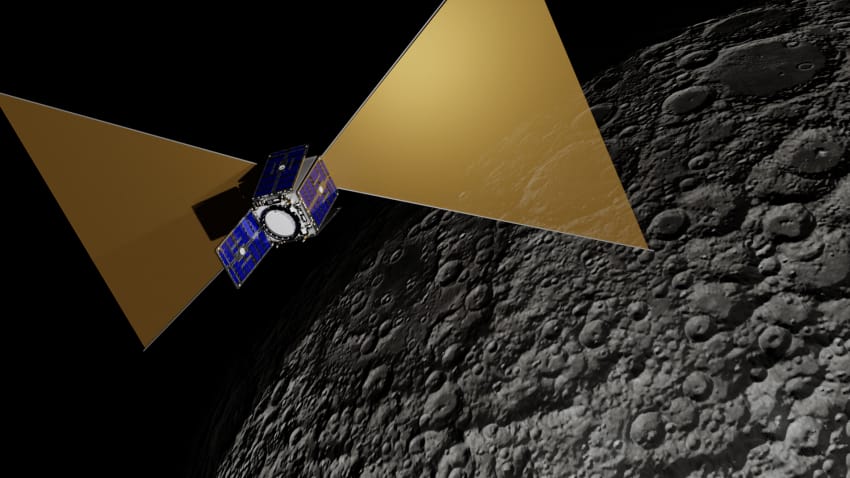
A render of the CosmoCube spacecraft. Once deployed it would listen out for an “ancient whisper” from the early universe on the far side of the Moon. (Credit: Nicolo Bernardini (SSTL Ltd) & Kaan Artuc (University of Cambridge))
21 July, 2025
A UK-led consortium of scientists has proposed the CosmoCube mission to study the universe’s Cosmic Dark Ages, an era before the first stars and galaxies formed, by deploying a miniature radiometer-equipped satellite to orbit the Moon’s far side. This location offers a rare radio-quiet environment, shielded from Earth’s interference, ideal for detecting faint hydrogen signals emitted over 13 billion years ago. Operating at low frequencies (10–100 MHz), CosmoCube aims to capture redshifted 21cm radiation, potentially illuminating early cosmic structure formation and dark matter-baryon interactions.
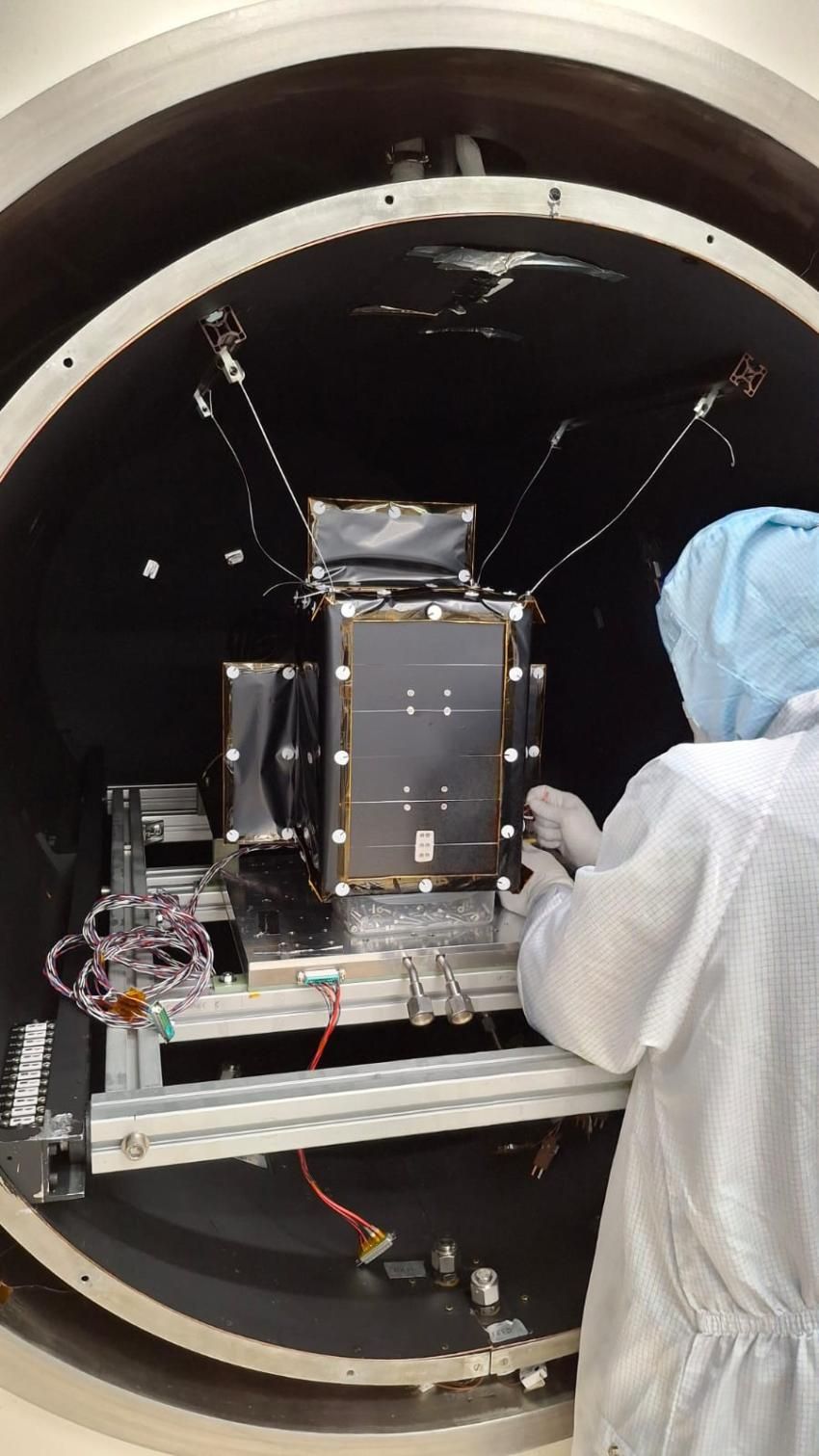
A model of the CosmoCube satellite undergoes thermal vacuum tests at the RAL Space facilities. (Credit: Dr Will Grainger, RAL Space)
The mission also seeks to address the Hubble tension, a persistent discrepancy in measurements of the universe’s expansion rate. Backed by the UK Space Agency’s Science Bilateral Programme, the project is undergoing prototype testing and targets launch within five years. If successful, CosmoCube could open a new observational frontier in cosmology, complementing Earth-based and orbital telescopes by accessing wavelengths otherwise blocked by the ionosphere and terrestrial noise.
Study Advances Matter-Antimatter Comparisons Using Quantum Techniques: Scientists Effectively Create an Antimatter Qubit
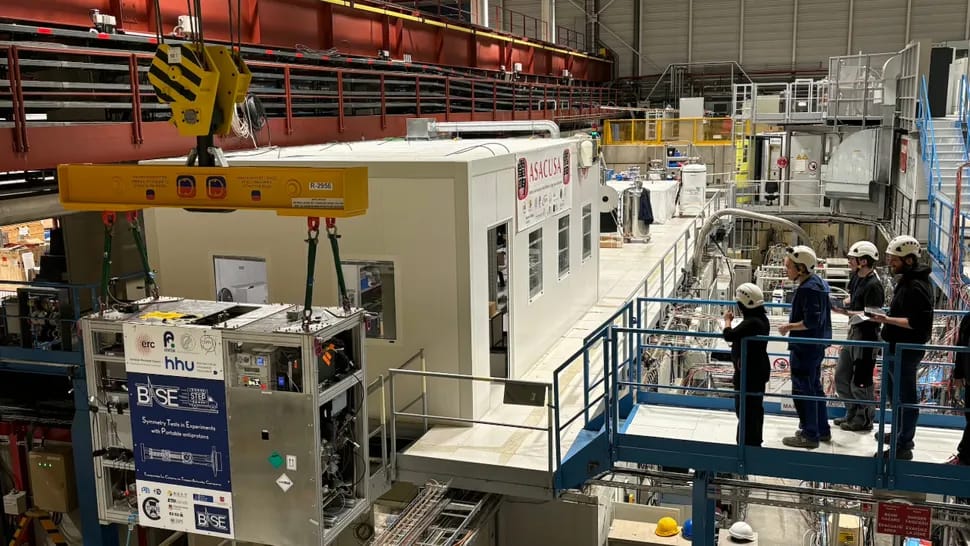
The BASE-STEP portable Penning trap, being lowered by crane (bottom left) at CERN. (Credit: CERN)
23 July, 2025
In a landmark experiment at CERN’s antimatter facility, the BASE collaboration has demonstrated the first coherent quantum transition in a single antiproton, effectively creating an antimatter qubit. By maintaining spin coherence for 50 seconds, researchers achieved unprecedented control over the particle’s quantum states, enabling more precise comparisons between matter and antimatter. This breakthrough refines tests of charge-parity-time (CPT) symmetry, a cornerstone of the Standard Model, and may expose subtle asymmetries that challenge current physics.
Spin coherence refers to the ability of a quantum system—typically involving particles like electrons or antiprotons—to maintain a stable and predictable quantum spin state over time. In simpler terms, it’s how long the “direction” of a particle’s spin remains well-defined before it gets scrambled by interactions with its environment. BASE stands for Baryon Antibaryon Symmetry Experiment. It’s a precision physics initiative at CERN focused on comparing the fundamental properties of protons and antiprotons—like their magnetic moments and charge-to-mass ratios—to test CPT symmetry and probe why the universe favors matter over antimatter.
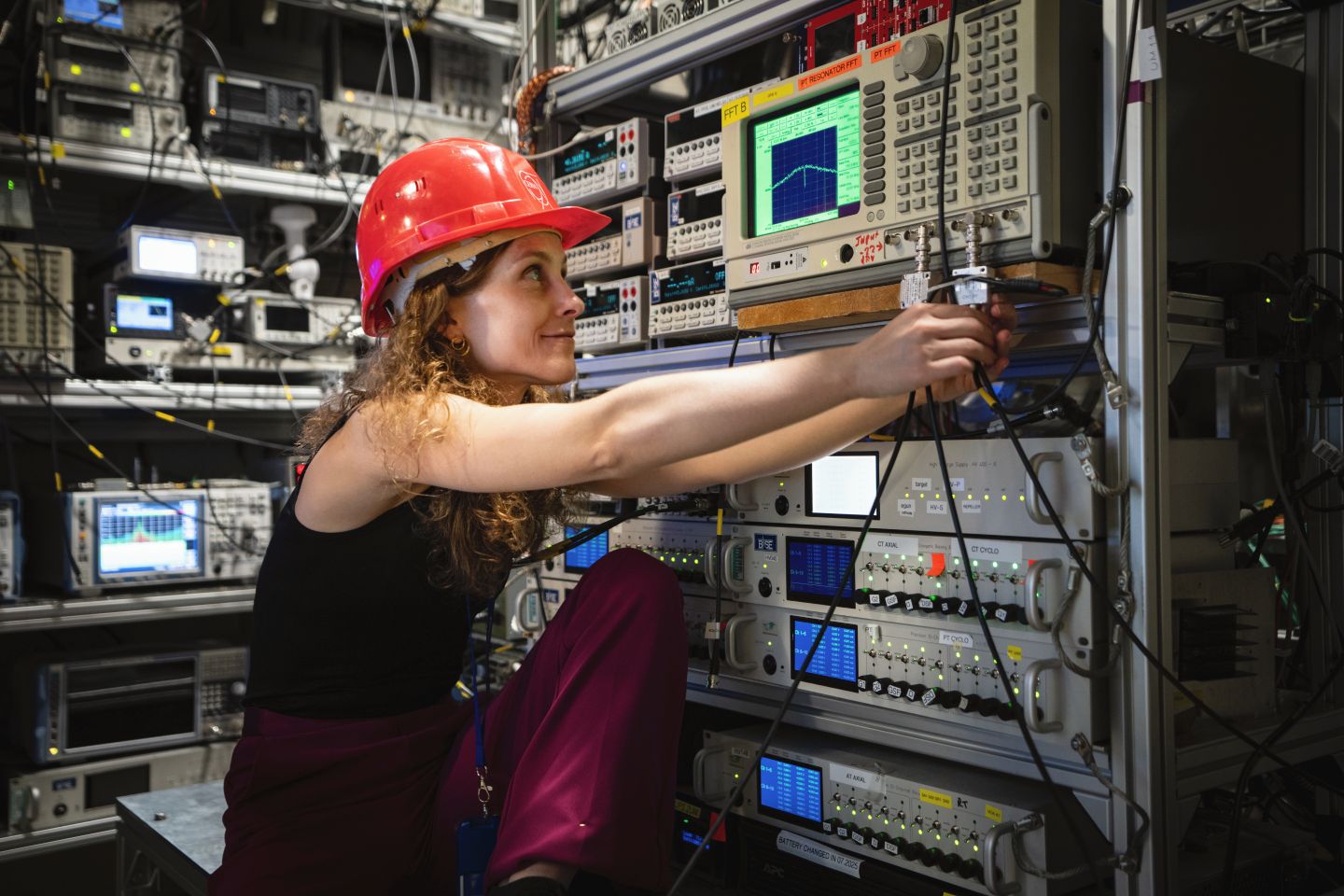
Physicist Barbara Latacz working in the BASE experiment. (Credit: CERN)
The experiment’s success hinged on suppressing decoherence mechanisms and deploying advanced Penning trap systems. It’s basically a tiny, invisible cage built with magnets and electric fields, that lets researchers study particles in isolation for long periods, without smashing them or losing them.
While the antimatter qubit is unlikely to serve computational functions, it opens new avenues for high-precision spectroscopy and fundamental physics. Future upgrades, including BASE-STEP’s transportable trap system, aim to extend coherence times tenfold, potentially transforming baryonic antimatter research. The findings underscore the growing intersection of quantum control and particle physics in probing the universe’s deepest symmetries.
NASA–ISRO Earth Observation Satellite Set for July 30 Launch: Will Target Climate & Geohazard Monitoring at Sub-Centimeter Scale

The NISAR satellite is preparing for encapsulation within the payload fairing of the GSLV Mark 2 launch vehicle, scheduled for liftoff on July 30. (Credit: ISRO)
23 July, 2025
NASA and ISRO are set to launch NISAR, a joint Earth-observation satellite, on July 30 from India’s Satish Dhawan Space Centre. The mission marks the first equal partnership between the two agencies and features dual-frequency synthetic aperture radar—NASA’s L-band and ISRO’s S-band—designed to detect sub-centimeter changes in Earth’s surface. NISAR will scan the globe every 12 days, enabling sub-centimeter, high-resolution monitoring of tectonic shifts, glacier dynamics, vegetation, and infrastructure vulnerabilities. Its data could improve disaster preparedness by identifying precursors to earthquakes, landslides, and volcanic activity.
The satellite’s 12-meter mesh antenna and repeat-pass interferometry will allow scientists to track subtle deformations over time. With a projected cost of $1.5 billion, NISAR is among the most advanced Earth science missions to date. The collaboration reflects a broader trend of bilateral space cooperation and underscores the strategic importance of Earth systems monitoring amid climate and geohazard challenges.
Satellite and AI Analysis Reveals that Strong Marine Protections Effectively Deter Illegal Fishing
24 July, 2025
A new peer-reviewed study published in Science demonstrates that fully and highly protected marine areas (MPAs) are effective in deterring industrial fishing, challenging assumptions that such zones are merely symbolic. Researchers combined satellite radar imagery, Automatic Identification System (AIS) data, and AI models to detect fishing vessels, including “dark” ships that evade tracking, across 1,380 MPAs. The analysis revealed that 78.5% of these zones showed no commercial fishing activity, and those with violations averaged less than 24 hours of activity annually.
"The ocean is no longer too big to watch.”
"With cutting-edge satellites and AI, we're making illegal fishing visible and proving that strong marine protections work."
Strictly protected MPAs had nine times fewer vessels per square kilometer than unprotected areas. The findings suggest that robust enforcement mechanisms and legal protections correlate with ecological benefits, including increased fish populations and spillover effects into adjacent waters. The methodology offers a scalable framework for monitoring compliance and guiding patrol efforts. As satellite and AI capabilities advance, the ocean is becoming increasingly transparent, reshaping global approaches to marine conservation and resource governance.
Ocean Temperature Anomalies Signal Climate Tipping Point: Satellite Data Confirms Record-Breaking Marine Heatwaves in 2023
24 July, 2025
In 2023, satellite data revealed an alarming surge in marine heatwaves, marking the most intense, widespread, and persistent ocean warming events on record. Covering 96% of global oceans, these anomalies lasted up to 525 days in regions like the North Atlantic and Southwest Pacific, with temperature spikes reaching 1.63°C during El Niño development. Researchers attribute the phenomenon to reduced cloud cover, weakened winds, and altered ocean currents—factors that intensified surface heating and disrupted vertical mixing.
In the study, Chinese researchers leveraged ECCO2 and OISST datasets, to suggest that these events may signal a shift in ocean-atmosphere dynamics, potentially approaching a climate tipping point. Ecological consequences include mass coral bleaching, species redistribution, and declining fisheries, with broader implications for coastal economies and global climate stability. While causality remains complex, the findings emphasize the urgency of advancing predictive models and mitigation strategies as ocean systems exhibit signs of systemic stress.
Standardized Supernovae Catalog Challenges Existing Cosmological Framework: Dark Energy is Evolving
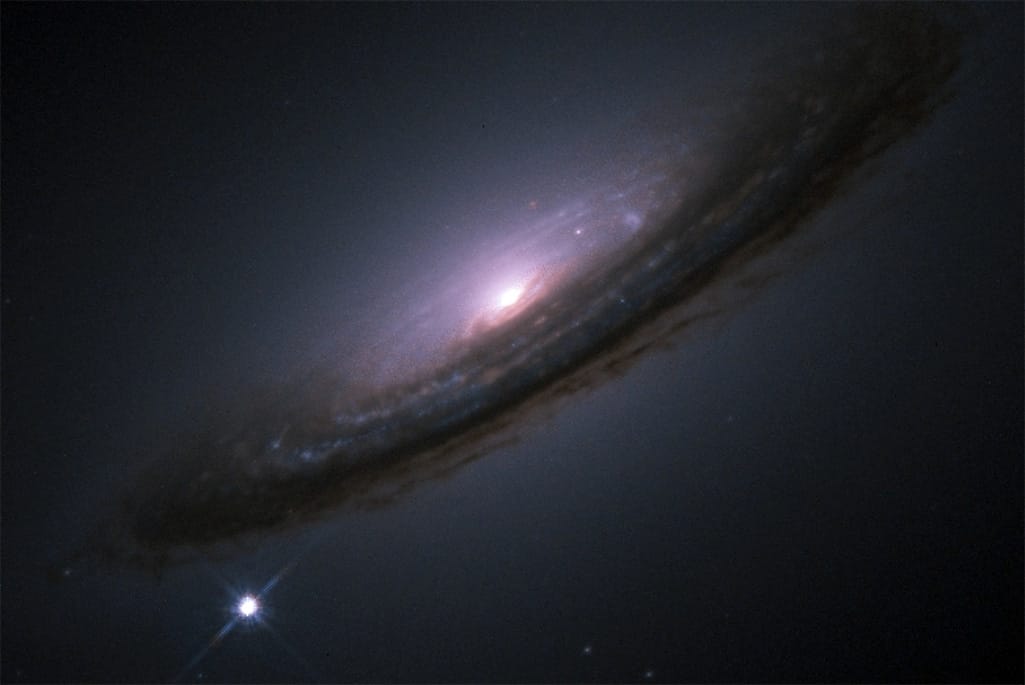
The bright dot of Supernova 1994D appears next to galaxy NGC 4526. (Credit: NASA, ESA, The Hubble Key Project Team, and The High-Z Supernova Search Team)
24 July, 2025
A new standardized dataset of 2,087 Type Ia supernovae, Union3, has intensified scrutiny of dark energy’s behavior over cosmic time. Compiled by the Supernova Cosmology Project, the catalog spans 7 billion years and corrects for instrumental inconsistencies across 24 surveys. Its analysis suggests that dark energy, long assumed constant under the Lambda-CDM (Cold Dark Matter) model, may be evolving. This aligns with independent findings from DESI and the Dark Energy Survey, both hinting at a weakening force behind cosmic expansion. The Lambda-CDM model is the leading framework in cosmology for describing the structure and evolution of the universe.
Researchers used Bayesian Hierarchical Models to refine calibration and account for observational uncertainties, improving confidence in the results. While not yet conclusive, the convergence of multiple methodologies has prompted renewed debate about the universe’s long-term trajectory. Upcoming data from the Vera Rubin Observatory and Roman Space Telescope may clarify whether the cosmos will expand indefinitely or face a more complex fate. The findings mark a pivotal moment in observational cosmology, challenging long-held assumptions about the dark universe.
Russia Completes Space Weather Constellation, Launches Iran’s Telecom Satellite
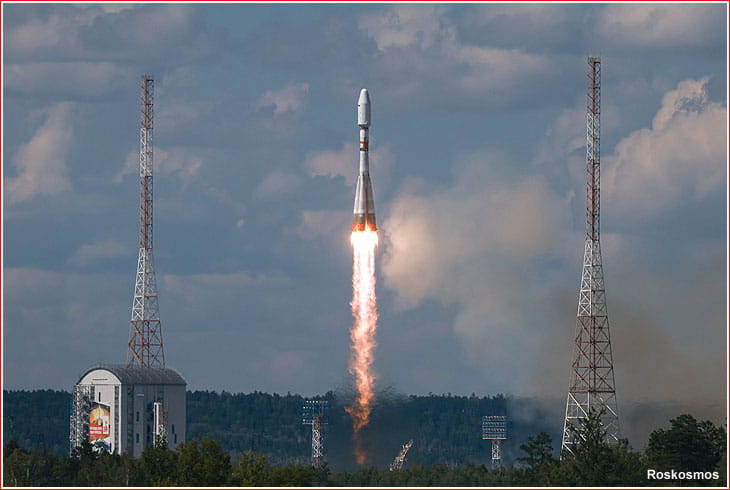
A Russian Soyuz rocket launches the Ionosfera-M 3 and 4 spacecraft, along with 18 secondary payloads, from Vostochny Cosmodrome on July 25, 2025. (Credit: Roscosmos)
25 July, 2025
Russia launched two Ionosfera-M satellites and Iran’s Nahid-2 communications satellite aboard a Soyuz 2.1b rocket from Vostochny Cosmodrome on July 25, completing a four-satellite constellation to monitor space weather phenomena. The Ionosfera-M 3 and 4 spacecraft entered an orbital plane perpendicular to their predecessors, enhancing three-dimensional coverage of the magnetosphere and ionosphere. Equipped with nine instruments—including spectrometers, magnetometers, and ozone sensors—the satellites will support geophysical research and civilian-military forecasting.
Iran’s Nahid-2, designed for telecommunications, reflects growing Russo-Iranian space cooperation following prior launches of Kowsar, Hodhod, and Pars-1 satellites. The mission also included 17 Russian cubesats for remote sensing and technology demonstration. While Roscosmos faces budget constraints, the Ionozond program continues to advance Russia’s scientific capabilities. The launch underscores the strategic use of space infrastructure for environmental monitoring and geopolitical alignment, particularly as Iran seeks self-sufficiency in satellite development.

GOVERNANCE
South Korea Unveils 2045 Lunar Base Roadmap
20 July ,2025
South Korea has unveiled an ambitious roadmap to establish a lunar base by 2045, positioning itself among a growing cohort of nations pursuing long-term habitation on the Moon. The Korea AeroSpace Administration (KASA), formed in 2024, outlined five core mission areas, ranging from low Earth orbit to deep space, with lunar exploration as a central pillar. Plans include developing indigenous landing and mobility technologies by 2040, followed by infrastructure to support a “lunar economic base” five years later.
Early groundwork is underway: prototype rovers are being tested in terrestrial mines to simulate lunar conditions, and the Danuri orbiter, launched in 2022, continues to relay data from lunar orbit. South Korea’s lunar ambitions mirror broader geopolitical trends, with the U.S., China, Russia, and India also targeting permanent Moon outposts. KASA’s roadmap reflects a strategic pivot toward resource utilization and autonomous capability, signaling the country’s intent to become a serious player in the off-Earth economy.
Scientists Flag Safety Risks as NASA Workforce Shrinks Under Budget Pressure

Supporters including NASA staff, contractors, and families assembled near the Smithsonian Air and Space Museum on July 20. (Credit: Space.com/Josh Dinner
22 July, 2025
NASA is undergoing a period of acute internal disruption as nearly 4,000 employees—roughly 20% of its workforce, have accepted voluntary buyouts amid sweeping budget cuts proposed by the Trump administration. The reductions, which preempt congressional approval, target science programs and workforce structures, prompting widespread concern over mission integrity and institutional knowledge loss. Protesters gathered on July 20 outside the Smithsonian Air and Space Museum to mark the anniversary of Apollo 11 and to denounce what they described as premature and unlawful implementation of budget directives.
Lawmakers have accused NASA leadership of overcompliance with the proposed fiscal year 2026 budget, which slashes the Science Mission Directorate by nearly 50% and threatens over 40 missions. In response, nearly 300 current and former NASA personnel signed the Voyager Declaration, warning that political interference and abrupt restructuring jeopardize decades of progress in space, aeronautics, and climate science. The declaration also highlights the erosion of NASA’s Technical Authority, a safety oversight system established after the Columbia disaster.
The Deferred Resignation Program has accelerated departures, including senior leadership, raising fears of a “brain drain” that could compromise astronaut safety and future exploration. Protesters and signatories argue that NASA’s public science mandate is being undermined by short-term political agendas, with some scientists considering relocation abroad. As Congress pushes back, the agency faces a critical juncture: whether it can preserve its scientific mission and workforce or risk long-term damage to U.S. space leadership.
Spain Offers €400M Lifeline to Stalled Thirty Meter Telescope Project
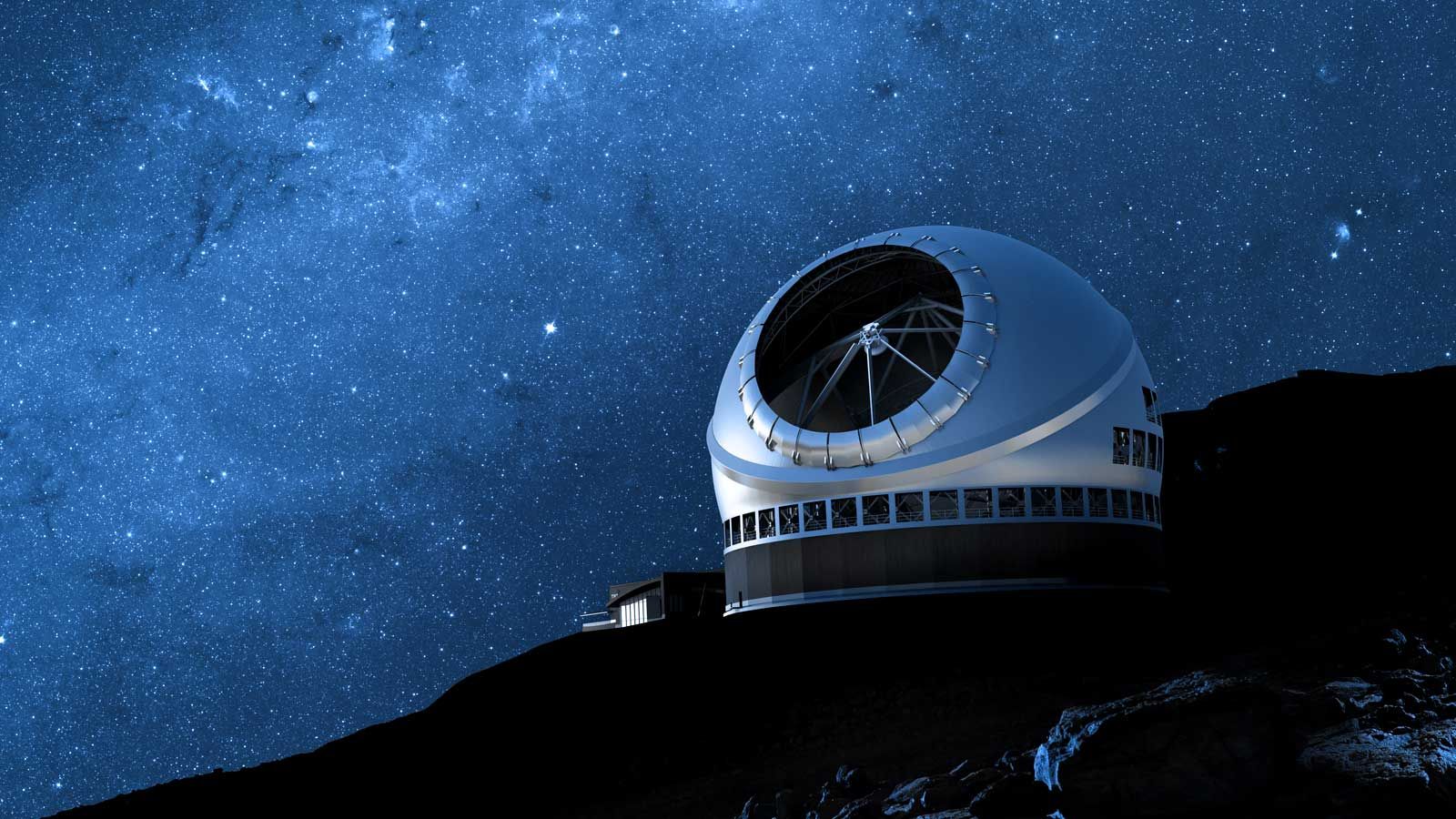
A rendering of the TMT dome at twilight. (Credit: Thirty Meter Telescope)
23 July, 2025
Facing potential cancellation under the Trump administration’s FY2026 budget proposal, the Thirty Meter Telescope (TMT) has received a lifeline from Spain. The Minister of Science, Innovation and Universities in Spain, Diana Morant, announced that Spain has formally offered up to €400 million/$471 million to host the stalled observatory on La Palma in the Canary Islands. The proposal follows the Trump administration’s FY2026 budget request, which recommends withdrawing National Science Foundation’s (NSF) support for the TMT, citing a preference for the Giant Magellan Telescope in Chile. Prior to Trump’s presidency, the NSF had faced government pressure to fund just one large ground-based telescope, capped at $1.6 billion—a concern given that these two such projects were already underway.
The offer was framed as a strategic investment in global scientific infrastructure, emphasizing La Palma’s readiness and existing permits. Originally slated for Hawaii’s Mauna Kea, the TMT has faced years of delays due to local opposition and funding constraints. Spain’s bid positions the Canary Islands as a northern hemisphere alternative, though the site’s lower altitude may affect observational quality. If accepted, the move could secure decades of research, skilled employment, and regional development. The TMT board is expected to review the proposal within months.
US NOAA Satellite Division Head & Sharpiegate Investigator Placed on Leave
25 July, 2025
Two senior officials at NOAA, Stephen Volz, head of the satellite division, and Jeff Dillen, deputy general counsel, have been placed on administrative leave, raising questions about political interference and scientific integrity. Both played key roles in investigating the 2019 “Sharpiegate” incident, in which NOAA backed President Trump’s altered hurricane forecast map. Their removal comes days before a Senate vote on Neil Jacobs, Trump’s nominee to lead NOAA, who was previously found to have violated agency ethics during the same scandal.
The timing has sparked concern among current and former NOAA staff, especially as the Trump administration pushes for deep budget cuts and privatization of satellite operations. Volz had publicly advocated for maintaining government-led satellite infrastructure while selectively partnering with private firms for data. With NOAA already facing staffing shortages and morale challenges, the sidelining of these officials adds to broader unease about the agency’s future direction and its ability to uphold scientific standards

MILITARY
US Reconnaissance Office Taps Hydrosat for On-Orbit Thermal Infrared Data

Credit: Hydrosat
21 July, 2025
Washington D.C.-based thermal satellite data provider, Hydrosat has secured a Stage II contract with the National Reconnaissance Office (NRO), expanding its role in the Strategic Commercial Enhancements program. The agreement grants the NRO access to thermal infrared and electro-optical data from Hydrosat’s first two satellites, VanZyl-1 and VanZyl-2, which together image over 10 million square kilometers daily. This follows a Stage I contract awarded in 2023 for modeling and simulation work. The new deal enables on-orbit assessments and operational use of Hydrosat’s data for defense and intelligence applications, including nighttime surveillance and infrastructure detection.
Hydrosat’s thermal imagery is also used for agricultural monitoring, drought detection, and irrigation optimization. The company’s AI-ready datasets offer high-frequency, machine-readable surface temperature insights. CEO Pieter Fossel emphasized the strategic value of thermal data in overcoming limitations of optical systems, particularly in low-light conditions. The contract reflects growing demand for commercial sensing capabilities across U.S. government agencies.
Space Force Simulates Commercial Satellite Mobilization in Orbital Crisis Drill
21 July, 2025
In a recent two-day exercise in Colorado Springs, the U.S. Space Force tested its ability to mobilize commercial satellite assets during orbital emergencies, marking the second iteration of its Commercial Augmentation Space Reserve (CASR) wargames. The drill simulated scenarios where private-sector capabilities could be rapidly integrated into military operations, reflecting growing interest in leveraging commercial infrastructure for national security. CASR draws conceptual parallels to the Civil Reserve Air Fleet, aiming to formalize partnerships that ensure surge capacity in contested space environments.
This rehearsal comes amid broader efforts to define “orbital warfare” and enhance space domain awareness, electromagnetic operations, and navigational resilience. While details remain sparse, the exercise underscores the Space Force’s intent to build a flexible, hybrid architecture that blends public and private assets. As geopolitical tensions rise and satellite vulnerabilities increase, such initiatives signal a shift toward distributed, responsive space defense strategies.
Space-Based Missile Defense Gains Momentum with Interagency Push Across US Initiatives: Golden Dome to be Functional in 3 Years

Vice Chief of Space Operations Gen. Michael Guetlein. (Credit: U.S. Air Force)
23 July, 2025
The U.S. national security space architecture is undergoing a rapid transformation, with multiple initiatives converging around missile defense, satellite surveillance, and commercial integration. The Space Development Agency (SDA) is nearing a pivotal moment as it prepares to deploy hundreds of low-Earth orbit satellites under its Proliferated Warfighter Space Architecture. These launches will test whether SDA’s spiral development model—emphasizing speed, scale, and cost-efficiency—can deliver a resilient network for missile tracking and tactical communications.
Meanwhile, the Space Force is replacing its bespoke GSSAP satellites with commercially built alternatives for geostationary surveillance, aiming to reduce costs and improve interoperability with allies. At the strategic level, the Golden Dome initiative, announced by President Trump and led by Gen. Mike Guetlein, seeks to build a layered homeland missile defense system within three years. The plan includes space-based interceptors, which Guetlein claims are technically feasible and already tested in ground-based trials.
Golden Dome envisions a multi-domain shield against ballistic, hypersonic, and cruise missiles, integrating land, sea, and space-based interceptors with AI-driven sensor fusion. The initiative draws inspiration from Israel’s Iron Dome but scales it to continental dimensions, requiring thousands of satellites and interceptors in orbit. Congress has allocated $25 billion as an initial down payment, with total costs projected to exceed $175 billion. The Pentagon is pursuing incremental demonstrations every six months, while leaning on commercial firms like Northrop Grumman, Lockheed Martin, and Amazon’s Project Kuiper to accelerate deployment.
Critics warn of technical and strategic risks, including feasibility concerns and the potential for an arms race. Nonetheless, Golden Dome reflects a broader shift toward distributed, responsive space defense, one that blends legacy systems, experimental platforms, and commercial capabilities into either a unified architecture or an improvised patchwork for homeland protection.
Spire Expands Space-Based RF Intelligence for Defense Applications
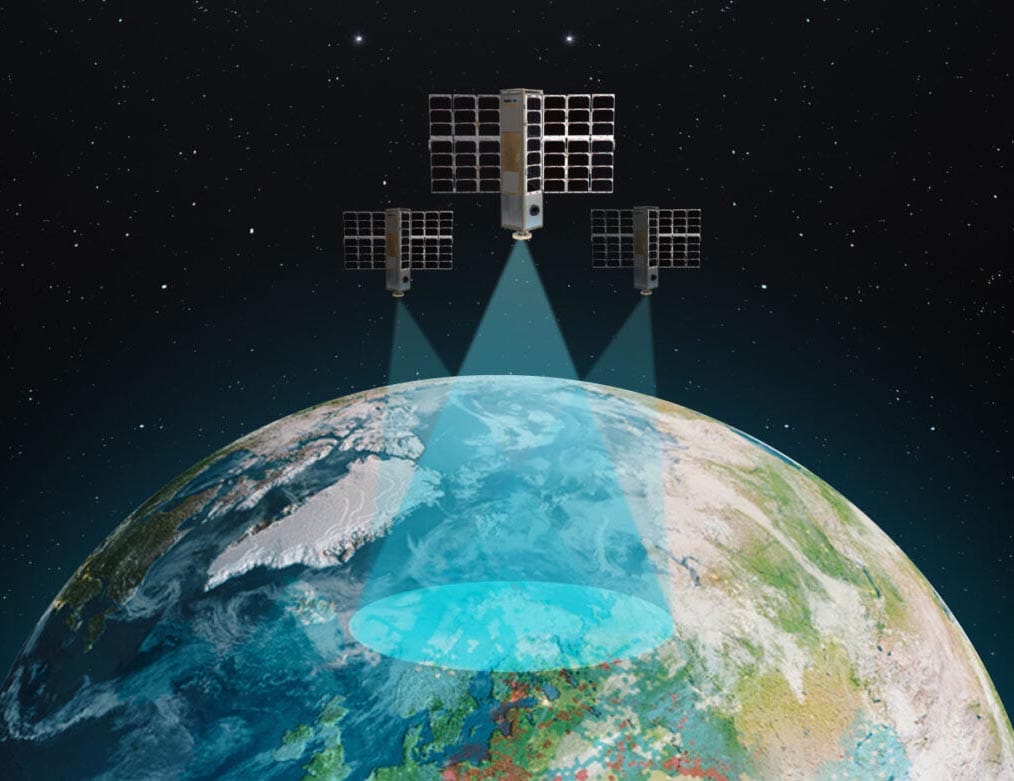
A rendering to depict RF detection from space. (Credit: Spire Global)
24 July, 2025
Spire Global has expanded its Space Reconnaissance portfolio with new AI enhanced, radio frequency (RF) geospatial intelligence capabilities aimed at defense and security sectors. The upgraded system enables persistent signal monitoring, real-time geolocation, and multi-layered situational awareness across land, sea, and air. Spire’s satellites, operating in VHF, UHF, and L bands, can detect unauthorized transmissions, track GNSS interference, and process unencrypted voice signals using AI for near-instant transcription and translation.
The data is delivered via secure cloud infrastructure, with sovereign-ready options for customers requiring full control. A $14 million contract from the U.S. Air Force Research Laboratory supports the deployment of satellite clusters designed to track moving objects on Earth, with launches planned through 2026. While Spire positions its RF tools as critical for modern threat detection, the expansion also reflects broader trends in commercial intelligence outsourcing and the growing role of private firms in national security architectures.

COMMERCIAL
AST SpaceMobile Seeks FCC Approval for Direct Satellite Coverage to First Responders
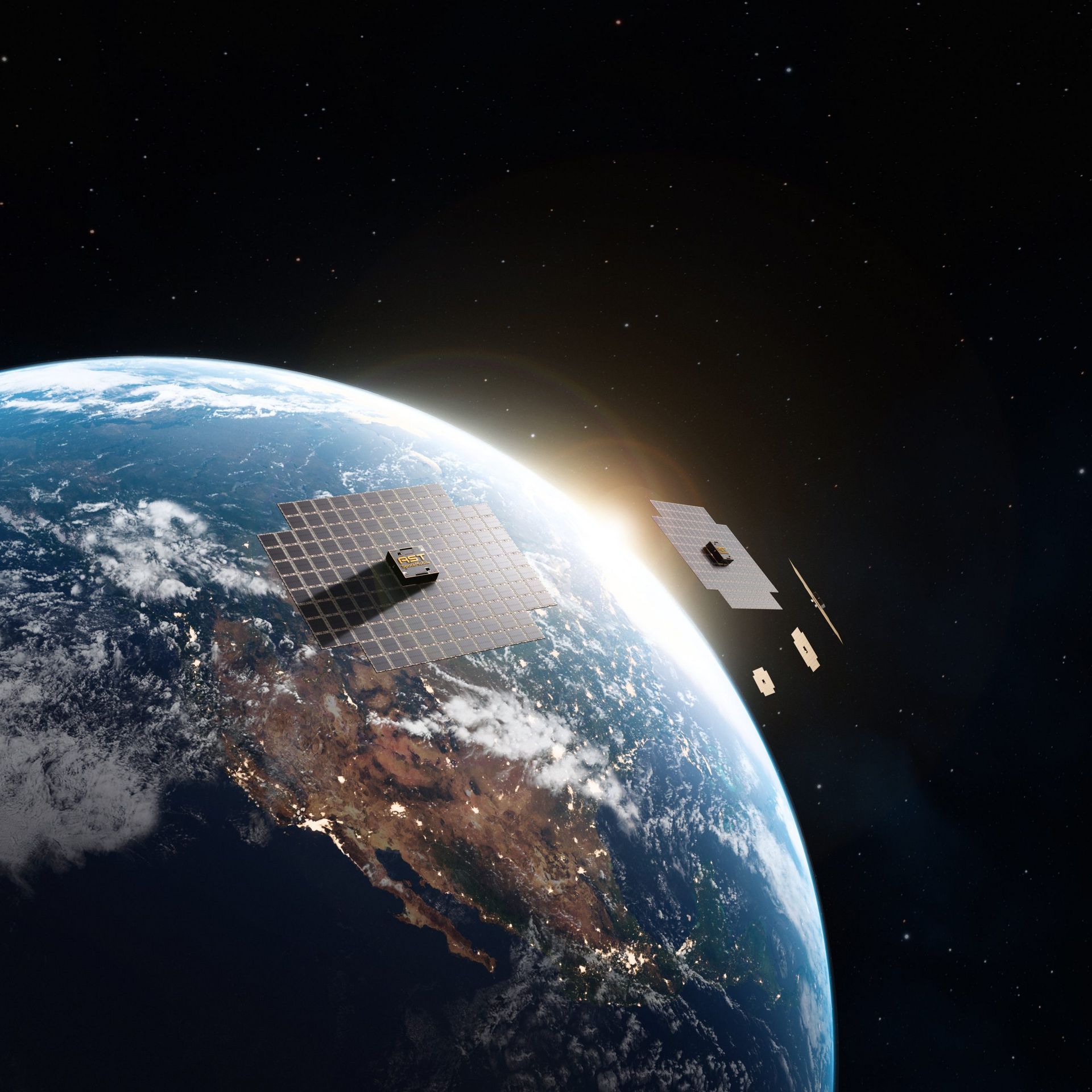
A rendering of AST SpaceMobile's five first-generation, Block 1 BlueBird commercial satellites in LEO. The spacecraft are designed to provide space-based cellular broadband service to unmodified mobile phones. (Credit: AST Spacemobile)
22 July, 2025
AST SpaceMobile, supported by AT&T, is advancing plans to commercially deploy direct-to-device (D2D) satellite connectivity for emergency responders across the U.S. It has filed with the Federal Communications Commission (FCC) to use 700MHz frequency band, also known as Band 14—already employed by FirstNet’s terrestrial network—for satellite-based coverage in disaster-prone and remote areas. The initiative builds on recent trials using AST’s BlueBird satellites, which launched in 2024 and are designed to enable direct cellular communication without ground infrastructure.
FirstNet is the United States’ dedicated wireless broadband network for first responders and public safety personnel. It was established in response to communication failures during the 9/11 attacks, with the goal of creating a resilient, nationwide system that prioritizes emergency communications.
FirstNet currently relies on satellite-equipped mobile units, such as SatCOLTs, during outages, but the D2D service aims to make satellite access seamless and device-native. AST’s constellation plans have scaled down from 170 to 100 satellites, with backing from AT&T, Verizon, and Vodafone. The move reflects growing interest in hybrid architectures that blend terrestrial and orbital assets for resilient public safety communications. As climate-driven disasters intensify, satellite-enabled redundancy is becoming a strategic priority for emergency infrastructure.
China Introduces Sector-Wide Standards for Space Infrastructure
23 July, 2025
China has introduced new regulatory measures to strengthen quality oversight across its rapidly expanding commercial space sector. The directive, issued by the China National Space Administration, outlines lifecycle management standards ranging from design and manufacturing to launch and decommissioning, aimed at curbing fragmentation and ensuring reliability. This move reflects growing concern over inconsistent practices among private firms, as the sector transitions from experimental launches to operational infrastructure.
Commercial space was designated a “new engine of economic growth” in China’s 2024 government work report, with projections placing its market value above 2.5 trillion yuan ($348 billion) by 2025. The new rules signal Beijing’s intent to shape the sector’s trajectory through centralized oversight, even as technological breakthroughs and launch capabilities accelerate. Analysts note that while the reforms may slow short-term innovation, they could stabilize long-term growth and reduce risk across public-private ventures. The shift underscores China’s evolving approach to industrial governance in space.
iRocket to Go Public Through $400 Million SPAC Merger

iRocket’s proprietary engine’s firing test shows non-thrust augmentation mode for higher-altitudes. (Credit: iRocket)
Used at higher altitudes, when less thrust but more Isp is reqruied.
23 July, 2025
Reusable launch startup iRocket (Innovative Rocket Technologies Inc.) is set to go public via a $400 million SPAC merger with BPGC Acquisition Corp., backed by former U.S. Commerce Secretary Wilbur Ross. Founded in 2018, iRocket specializes in liquid oxygen and methane-fueled propulsion systems designed for rapid reusability, positioning itself within a growing niche of cost-efficient launch providers. With over $1 billion in non-binding customer interest and partnerships with U.S. defense agencies, the company claims to offer rapid, 24-hour turnaround launches using its patented engines and solid rocket motors. The deal reflects renewed investor appetite for space infrastructure, as macroeconomic uncertainty and regulatory hurdles push smaller firms toward alternative listing strategies.
The SPAC raised $345 million in March 2021 but returned nearly all of it to shareholders after failing to secure an acquisition by September 2024. Following an additional $28.8 million redemption two weeks later, only $1.6 million, just 0.5% of the original capital, remained in trust. Despite the depletion, the remaining shareholders, mainly the sponsors, agreed to extend the deadline for identifying a target to March 2026.
This acquisition marks a notable rebound in space-related special purpose acquisition (SPAC) deals, following a slowdown since the 2020–21 surge and amid broader IPO stagnation. SPAC activity in 2025 has outpaced previous years, with 58 filings already recorded, signaling a shift in capital flows toward speculative but potentially transformative technologies. iRocket’s Nasdaq listing, expected by Q4, aligns with broader projections of a $1.8 trillion space economy by 2035, though analysts caution that market saturation and technical risk remain high. The transaction underscores how financial engineering continues to shape the trajectory of emerging space ventures.
Lockheed Eyes Selling Commercial Orion Flights for Deep Space After Artemis
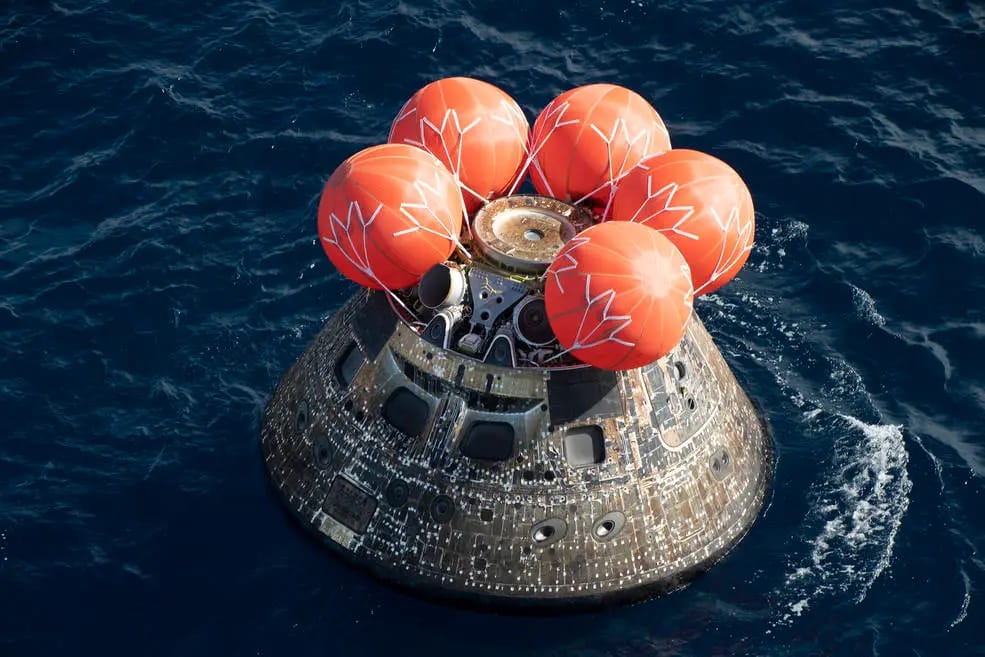
NASA’s Orion spacecraft for the Artemis I mission after splashing down in the Pacific Ocean, post 25.5 day mission to the Moon. (Credit: NASA/Dames M. Blair)
24 July, 2025
Lockheed Martin is exploring a shift in how its Orion spacecraft might be deployed, proposing future flights as fixed-price commercial services. This model could allow foreign space agencies to purchase crewed missions beyond Earth orbit, echoing recent private flights to the ISS by nations like Hungary and India. The company’s current NASA contract covers Orion capsules for the first six Artemis lunar landings, with an option for six more, but future missions may rely on refurbished vehicles to reduce costs.
This pivot comes amid political uncertainty: while the Trump administration’s FY2026 budget proposed phasing out Orion after Artemis III, Congress recently approved $20 billion to sustain the program through Artemis IV and beyond. Lockheed Martin’s strategy hinges on scaling production and enhancing reusability, positioning Orion as a platform not just for NASA’s lunar ambitions but potentially for broader international deep space access. The next crewed flight, Artemis II, remains slated for early 2026.
Spaceflux Secures £5.4M in Seed Funding to Expand Global SSA Network as Demand Rises for Non-US Situational Awareness Platforms
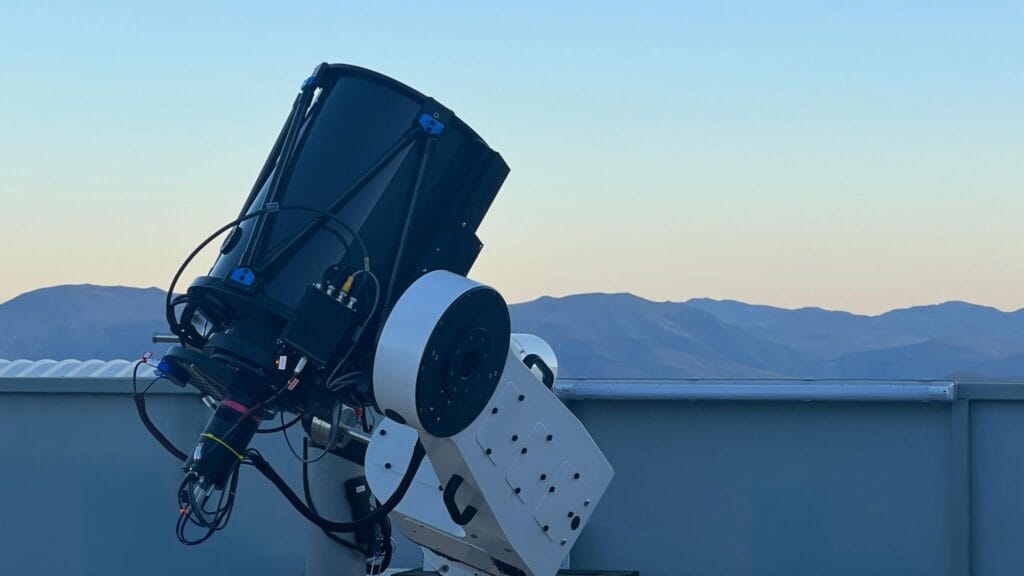
A Spaceflux sensor installed in Chile in 2023. (Credit: Spaceflux)
25 July, 2025
UK-based startup Spaceflux has secured £5.4 million/$7.31 million in seed funding to expand its global telescope network and enhance AI-powered space situational awareness (SSA) capabilities. The company aims to provide 24/7 tracking of satellites and debris across all orbital regimes, using optical sensors that combine visible and short-wave infrared imaging. Spaceflux’s Cortex analytics platform is central to its strategy, offering real-time insights for government, commercial, and insurance clients navigating orbital congestion and security risks.
Spaceflux intends to develop an independent catalog of space objects, potentially rivaling the U.S. Space Force’s database. The catalog could serve as a contingency for European stakeholders in the event of geopolitical tensions and data access limitations. Founded in 2022, Spaceflux has already partnered with the UK Space Agency and Ministry of Defence, positioning itself as a sovereign alternative in the increasingly contested domain of orbital surveillance. The funding reflects growing demand for resilient, non-U.S. SSA infrastructure.
Blue Origin to Launch Scout's AI-Based Orbital Surveillance Sensor Aboard Blue Ring in 2026
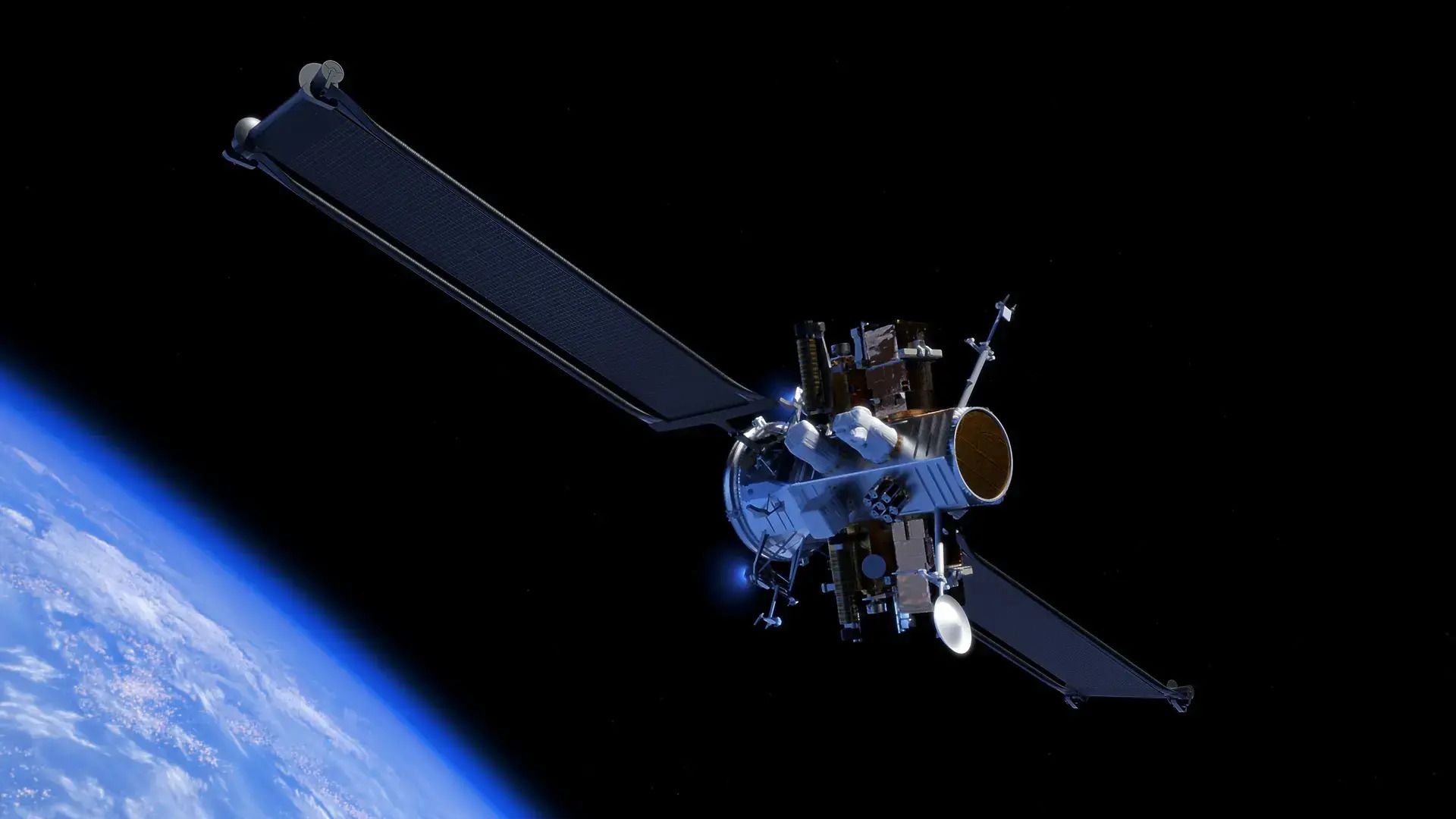
An illustration of Blue Origin's Blue Ring spacecraft platform, equipped with multiple payloads and components. (Credit: Blue Origin)
25 July, 2025
Blue Origin has announced that its modular Blue Ring satellite bus, will carry Scout Space’s Owl sensor on its first operational flight in spring 2026. Designed for geostationary orbit, the Owl sensor uses AI to autonomously detect, track, and characterize orbital objects—including satellites and debris—supporting both national security and commercial space domain awareness (SDA) efforts. The mission marks a shift in Blue Origin’s portfolio toward defense-oriented capabilities, aligning with U.S. Space Force priorities amid growing concerns over orbital congestion and geopolitical competition.
Blue Ring, which debuted with a pathfinder flight in January 2025, is capable of carrying 13 payloads and delivering up to 4,000 kg of payload to multiple destinations, including deep space. Its integration with Owl reflects a broader industry trend: leveraging AI and modular platforms to enhance orbital surveillance. Scout Space’s involvement underscores the increasing role of private actors in SDA, as governments seek resilient, distributed systems to monitor and secure critical orbital infrastructure.

RESEARCH SPOTLIGHT
Researchers Demonstrate Algae Growth Under Simulated Martian Pressures in Bioplastic Habitat Prototypes
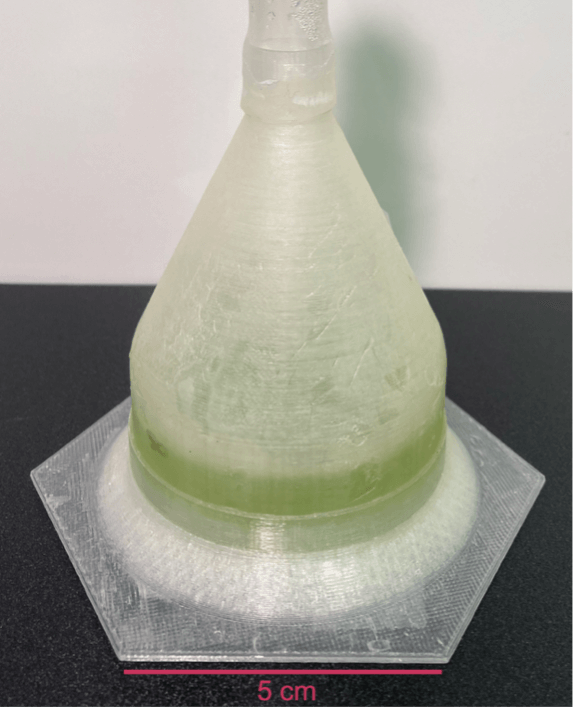
Close-up of bioplastic habitat with algae growth. (Credit: Harvard SEAS)
Harvard researchers have demonstrated algae growth inside bioplastic shelters under Mars-like conditions, advancing the concept of biologically generated habitats for space. Led by Robin Wordsworth, the international team of researchers used 3D-printed polylactic acid chambers to cultivate Dunaliella tertiolecta algae at 600 Pascals of pressure which is over 100 times lower than Earth’s, and in a CO₂-rich atmosphere. These chambers blocked harmful UV radiation while allowing photosynthesis, stabilizing liquid water through pressure gradients.
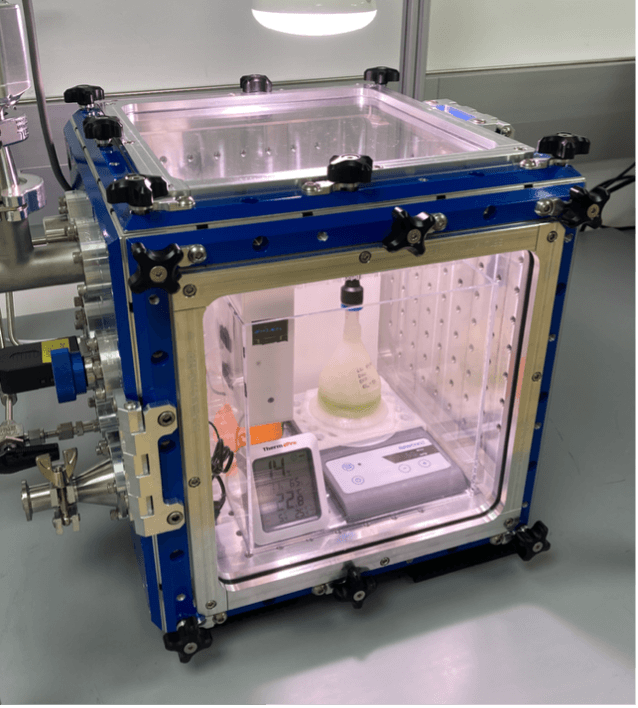
Bioplastic habitat inside the environmental growth chamber. (Credit: Harvard SEAS)
“If you have a habitat that is composed of bioplastic, and it grows algae within it, that algae could produce more bioplastic. So you start to have a closed-loop system that can sustain itself and even grow through time.
"The concept of biomaterial habitats is fundamentally interesting and can support humans living in space."
The experiment suggests a closed-loop system where algae can produce more bioplastic, reducing reliance on Earth-sourced materials. This approach contrasts with industrial terraforming, offering a biologically adaptive alternative for sustaining life in hostile environments. Combined with prior work using silica aerogels to retain heat, the research points to modular, self-sustaining habitats viable for Mars, lunar, or deep-space missions.
Beyond astrobiology, the findings hint at broader applications for sustainable infrastructure, challenging conventional assumptions about habitability and expanding the scope of life-support technologies in space.
Potentially Habitable Planet, a Super Earth, Confirmed Just 35 Light-Years Away

An artists' illustration of the planetary system of L 98-59. Five small exoplanets orbit closely around this red dwarf star, located 35 light-years away. In the foreground is the habitable-zone super-Earth L 98-59 f, whose existence was conùfirmed in this study. (Credit: Benoit Gougeon, Université de Montréal)
A team led by Université de Montréal’s Trottier Institute for Research on Exoplanets has confirmed a fifth planet in the compact L 98-59 system, located just 35 light-years away. The newly identified planet, L 98-59 f, resides in the star’s habitable zone and receives Earth-like stellar energy, raising prospects for liquid water. This non-transiting super-Earth was detected via radial velocity techniques using HARPS and ESPRESSO spectrographs.
The system’s other four planets, ranging from a sub-Earth to a possible water world, exhibit nearly circular orbits and diverse compositions, offering a rare laboratory for studying rocky planet formation around red dwarfs. Researchers achieved unprecedented precision by reanalyzing archival data from TESS, JWST, and ground-based observatories, applying novel analytical methods to filter stellar noise. The findings position L 98-59 alongside TRAPPIST-1 as a key target for atmospheric characterization and future biosignature searches, underscoring the scientific value of revisiting existing datasets with refined tools. The findings were published in the journal Earth and Planetary Astrophysics.
Despatch Out. 👽🛸


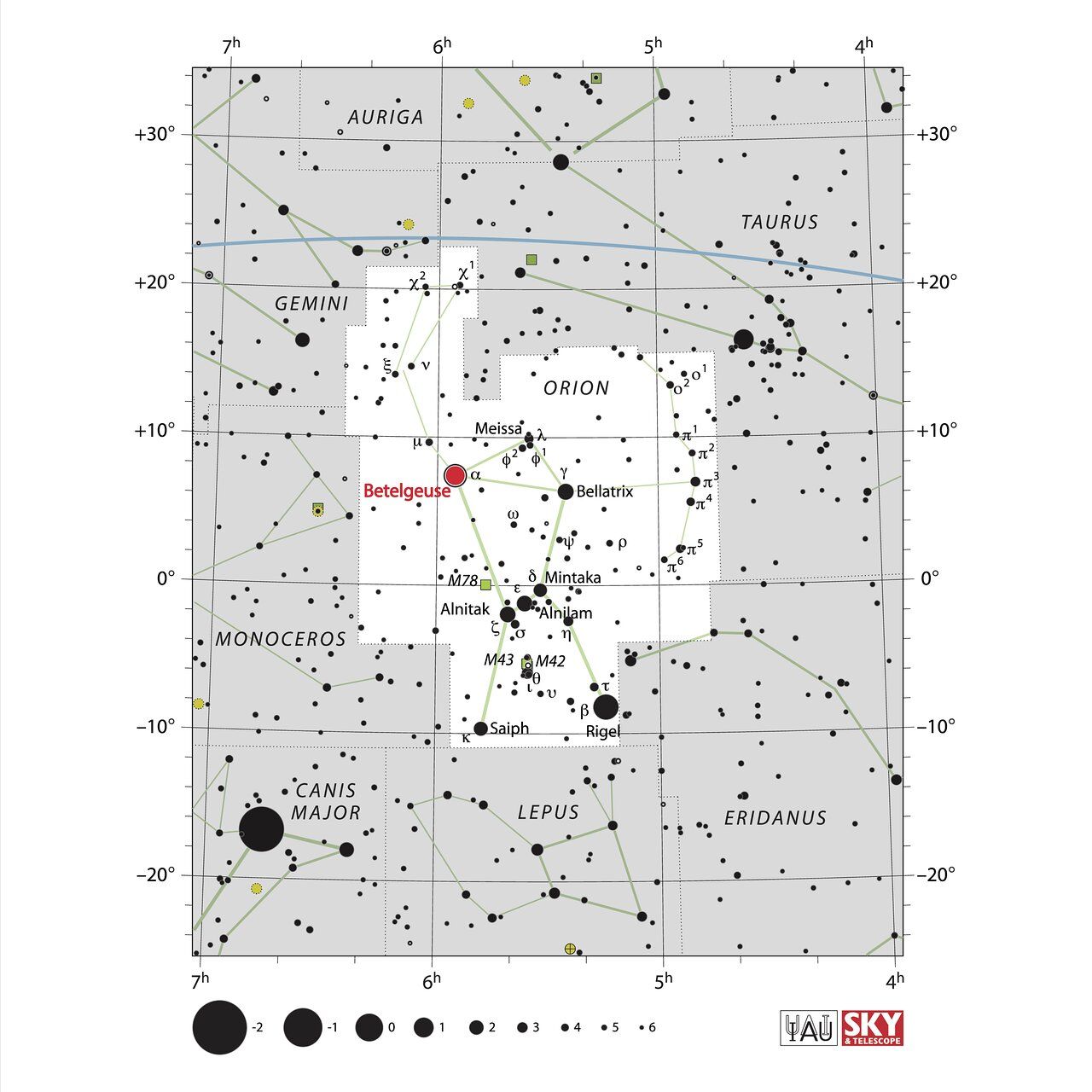
Reply